Boat Navigation Lights Rules: Illustrated Beginners Guide
When navigating at night, the lights on other boats are your first clue about the moving dangers around you. And your navigation lights are your first line of safety in avoiding collisions in the dark, and they tell others vessels what you are and what you are doing. The rules sound complex, but with a little understanding you can get the basics for any situation.
So what are the basic navigation light rules? For most small vessels, motoring requires red and green (port and starboard) lights, and a white light visible in all directions around the boat. This is almost always a stern light and a masthead light on sailboats. Boats under sail require port and starboard lights, and a white stern light. Sailboats below sixty-five feet may show a tricolor light at the masthead instead of side and stern lights when sailing.
That's it, in a nutshell. There's a little more to it, as the rules change with different sizes and there are some specifics about angles of display for the colors. Identifying other ships at sea requires more study, but the basics are the same. And it's not much trouble to make sure you've always got the proper lights on your vessel.
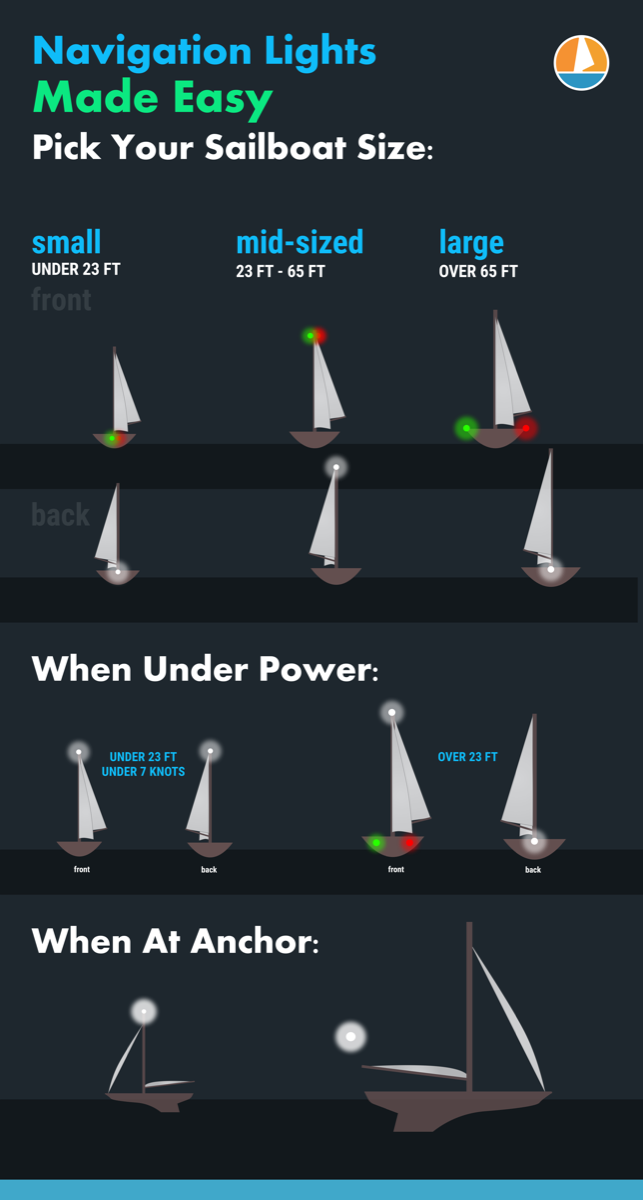

On this page:
What are the official colregs rules for your sailboat, what about the uscg (united states coast guard) rules, lighting at anchor, identifying the boats around you.
The International Regulations for the Prevention of Collision at Sea , abbreviated "COLREGS" is very specific about the lights required, their shapes and sizes, and the distance they must be visible. For the smaller boat, the following definitions apply.
- Masthead Light - a white light placed centerline on the boat showing an arc of 225 degrees with 112.5 degrees either side of the front of the vessel.
- Sidelights - A red light on the port side and a green light on the starboard. They must show an arc of 112.5 degrees from centerline of the bow.
- Stern light - A white light on the stern of the boat showing an unbroken arc of 135 degrees from centerline of the vessel.
- All-round light - A light showing in an unbroken arc of 360 degrees.
The good news is you need not measure these angles. Any properly installed USCG or COLREGS approved light which will cover the correct arcs. If you have to replace the original light from your boat, make sure it's with an approved replacement.
Lights When Sailing
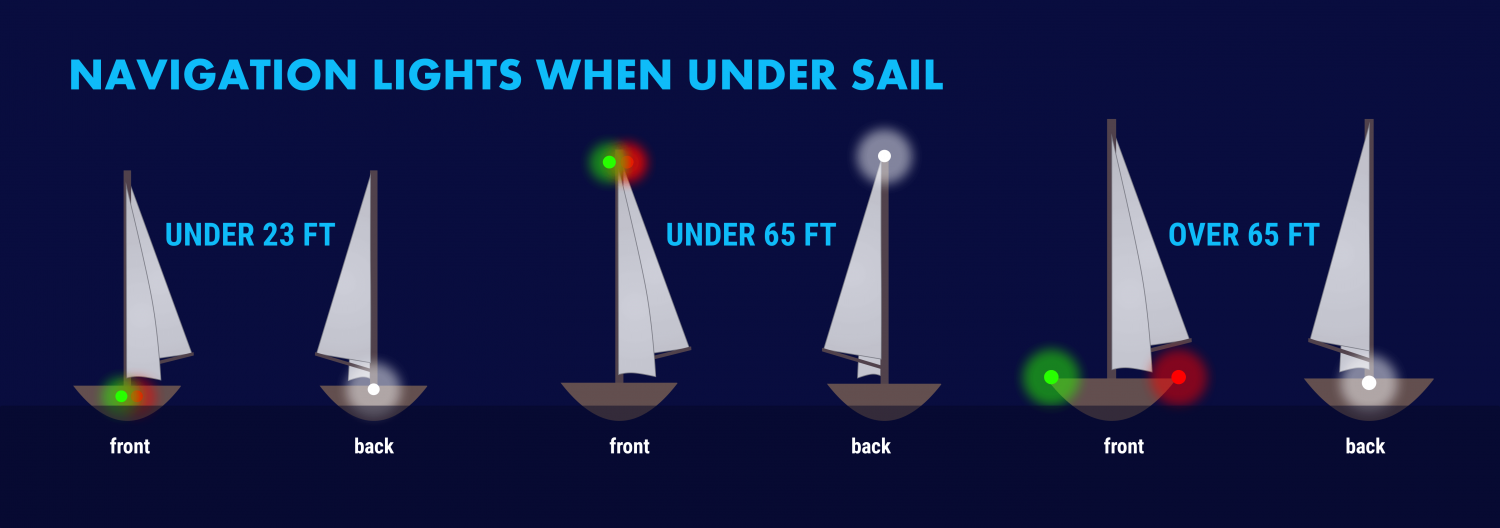
The specific rules for a sailboat under sail are in COLREGS Rule 25 and vary slightly with the size of the boat. A sailboat powering is considered a power boat and falls under in Rule 23.
- Under 23 feet (7 meters) - side lights and a stern light, possible. If these lights can not be displayed a light must be kept at hand to help avoid a collision. This can be a bright flashlight.
- Over 23 feet - Side lights visible to one nautical mile and stern light visible for two.
- Vessels under 65 feet may combine both sidelights into a single lantern on the bow.
- May show a tricolor light on the masthead instead of sidelights and a stern light. It's one or the other though, do not show these lights at the same time .
- Masthead light must be visible for three nautical miles, all other lights must have a two nautical mile visibility.
- Side lights must be separated.
- May not show a masthead tricolor light.
- Masthead light must have five nautical mile visibility, all other lights must be visible for two nautical miles.
- Optional masthead lights - any vessel under sail may display a red light over a green light at the masthead with sidelights and stern light. The red over green may NOT be displayed with a masthead tricolor light. It's one set or the other.
Lights When Motoring
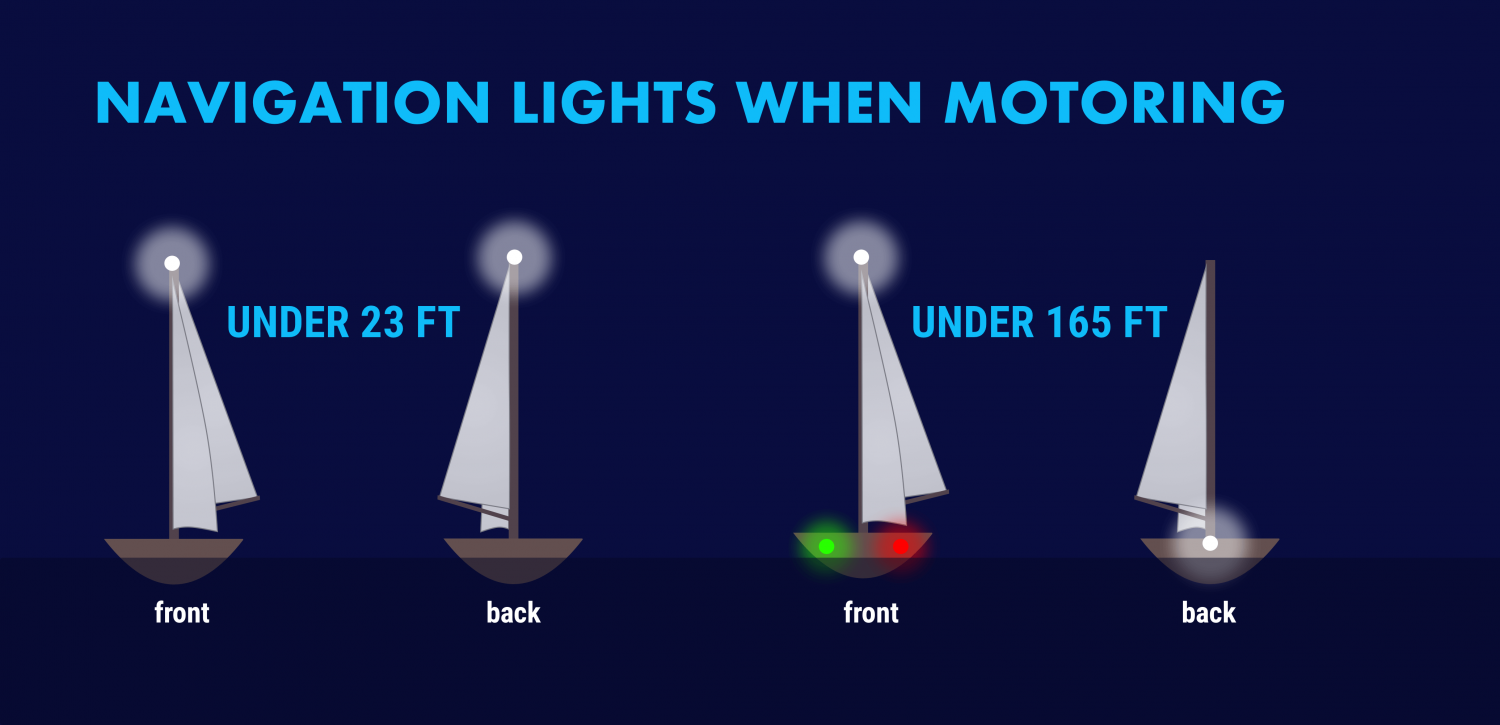
For all navigational purposes a sailboat under power is considered a power boat. This includes motor sailing - if the engine is on and providing propulsion you are on a power boat, even if the sails are up . This applies to navigation lighting, sound signals in fog and limited visibility, and rights of way.
Sailboats under 50 meters under power need to show:
- A masthead light
- Stern light
A power-driven vessel under 23 feet (7 meters) that does not exceed seven knots of speed may display an all around white light, though sidelights should be used if available.

The USCG has published its own "Rules of the Road" that are based on the COLREGS. In addition, it has rules for the "Inland Waterways" for rivers, inland lakes and the Great Lakes.
The good news is this has no impact on what you have to do with your own boat.
They mostly relate to lighting changes on towed vessels like barges and tugs. For example, a vessel towing or pushing another vessel in the ocean under COLREGS shows two masthead lights, sidelights and a stern light, whereas in Inland Waterways the towing or pushing vessel displays two yellow towing lights instead of a white stern light.
If you sail on lakes, rivers or the Great Lakes where towed commercial traffic is common you should learn the inland lights, but coastal or ocean sailors will never see these.
When you anchor outside a designated mooring field, you should display an all around white light at the masthead or as high in the boat as practical.
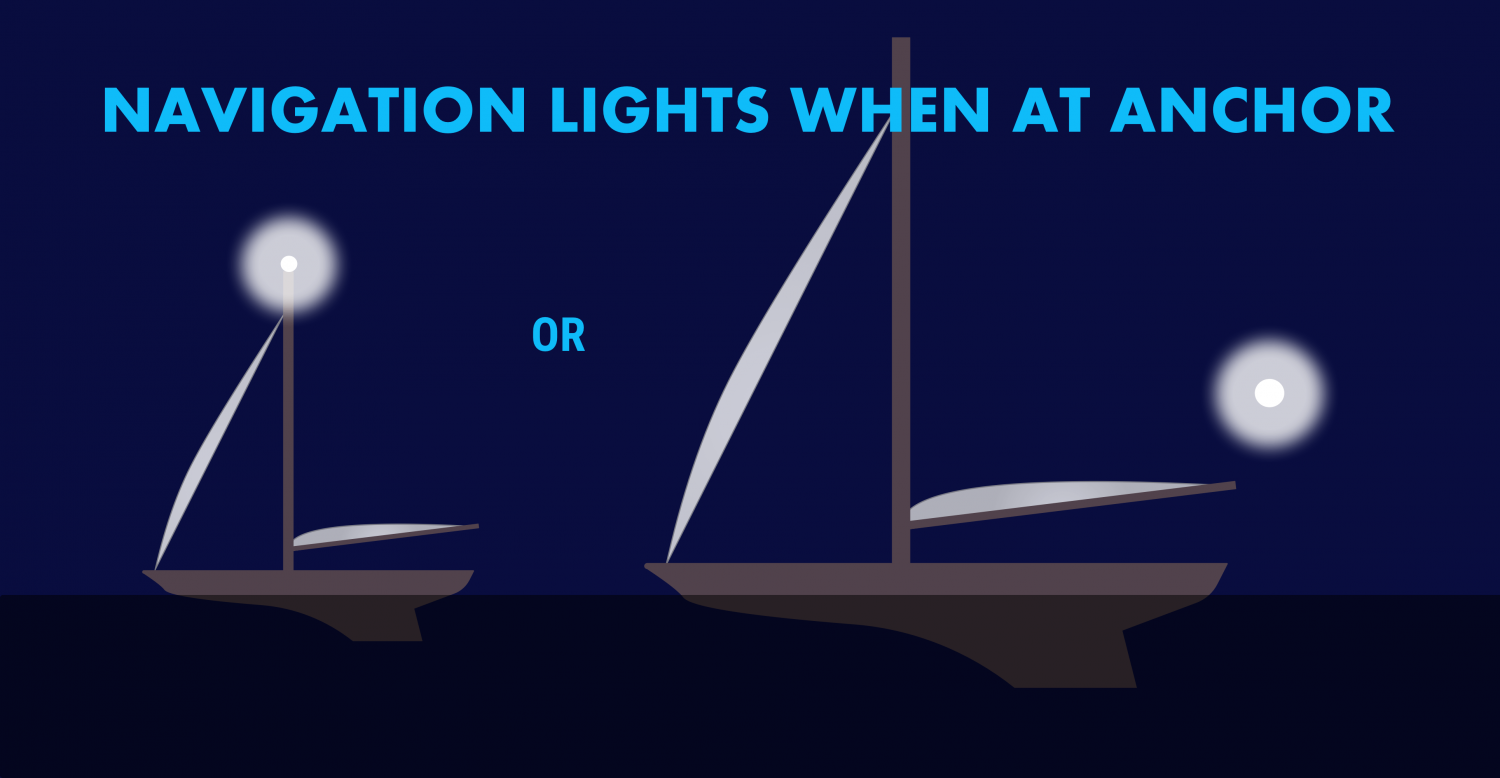
If your boat is large and has a very tall mast, you may wish to display another light closer to the waterline. Boats approaching in the dark may not see a light on a mast sixty or seventy feet in the air when they are close to your boat.
We use a simple garden path light on our stern when we anchor, left in a rod holder or flag socket. It comes on automatically at dusk and is a cheap and easy way to be more visible. There is no specific rule stating you can not display more lights than required, or the nature of any lights beyond the required all around light.
The COLREGS also specify that a round black "daymark" should be displayed in the rigging of any vessel at anchor. Very few small vessels observe this, however it is the correct display for a vessel in an anchorage.
If you tie to a mooring in a marked mooring area you are not required to display anchor lights, but there is no harm in doing so.
The other important reason to know your lights is to figure out what's going on around you at night. The water may be ablaze with white, red, green and other lights at night and they are your first key to avoiding collisions and problems.
All combinations of lights for fishing boats, commercial vessels, and so on are outside this post‘s scope. The odds are small you will encounter a submarine, seaplane or hovercraft at night, but there are regulations regarding specific lighting for each of those vessels!
There are a few fundamentals to help you figure out what that is you see on the horizon, which way it is going, and whether it is a danger to you.
Port Wine is Red
The fundamental rule is that red sidelights will ALWAYS be on the port side of a vessel, and green lights will always be on starboard. However, some vessels can use all around red and green lights for other purposes, though those will be higher than sidelights.

The light‘s on a ship is not important, some large tankers and freighters will have their sidelights far aft and put them on the superstructure for better visibility. It is not safe to assume that sidelights you can see are on the bow of large vessels .
When you can see the color, you know which way the bow is pointing. If it's red, it's pointing more or less to the left and will travel in that direction. A green light shows it is heading more or less to your right.
If you can see the red and green lights at the same time, you are looking directly at the bow of the vessel. When you are far away, this isn‘t as alarming as if you are close crossing. Seeing red and green lights together on a vessel is something you never want to see for long.
Be aware of red and green lights used in combination with other red, green and white lights. These may not be running lights and could have other significance.
Tankers, Freighters and Large Ships
Tankers, freighters and large ships will have side lights, a stern light and a masthead light. In addition, on vessels over 50 meters there will be a second masthead light further aft and higher than the forward light. The masthead light positions are a better tipoff to the bow direction and how far from the bow the sidelights might be. Remember - on a large vessel the sidelights may not be at the bow or even close to it.
USCG Inland Rules allow for a second all-around white light on large vessels on the Great Lakes instead of a second masthead light.
Fishing Boats
Fishing boats engaged in fishing will have more complex light displays. When they aren't fishing, they will show lights like any power vessel, but Rule 26 spells out light combinations that vary by the fishing activity being done. In general:
- Boats which are Trawling but not making headway will display a green all-around light over a white all-around light , and a masthead light aft of these lights. Boats making headway while trawling will show these lights, plus sidelights and a stern light.
- A vessel fishing other than trawling will show a red all-around light over a white all-around light . When making way they will also show sidelights and a stern light.
- If a vessel has gear more than 150 meters away from the boat, it will show a second all around light in the direction of the gear. The best rule is to give fishing boats as wide a berth as you can at night. They're easy to pick out if you check the top light configurations but their course may be difficult to predict.
Towing and Pushing
Towed vessels can be the most dangerous to cross, but they have the most lights to tell you what is happening. Refer to COLREGS or the USCG Rules of the Road Rule 24 for all combinations You can pick a tow/push vessel out with the following lights:
- Two or three masthead lights in a vertical line. Three masthead lights shows a tow over 200 meters. Additional masthead lights may show for larger tow vessels.
- A towing light (yellow light with the same characteristics as a stern light) directly above the stern light.
- The will also have side lights and a stern light.
- The towed vessel will show sidelights and a stern light. Lighting may vary under USCG inland rules, where towing lights may replace stern lights. Learn these differences if this is your regular cruising ground. If you think there is a tow ahead of you, always go well behind the aft most set of lights. Never go between a tow and avoid crossing ahead if possible as it may restrict their maneuverability.
Special Situations
There are several rare situations you may encounter. As a general rule, if there are a lot of lights and you don't understand them look for the sidelights on a moving vessel. If you can find them and figure out the direction it is moving, it makes the vessel easier to avoid. Stay well clear of lights you do not understand if you can avoid them without risk.
Most of these signals are used by larger, commercial vessels and you will not need them.
They use these light combinations with other light combinations. For example a towing vessel may also be restricted in maneuverability, and a vessel constrained by draft will show running lights if moving.
- Not Under Command - two all around red lights in a single line
- Restricted in Ability to Maneuver - red, white then red in a single line
- Constrained by draft - three all around red lights
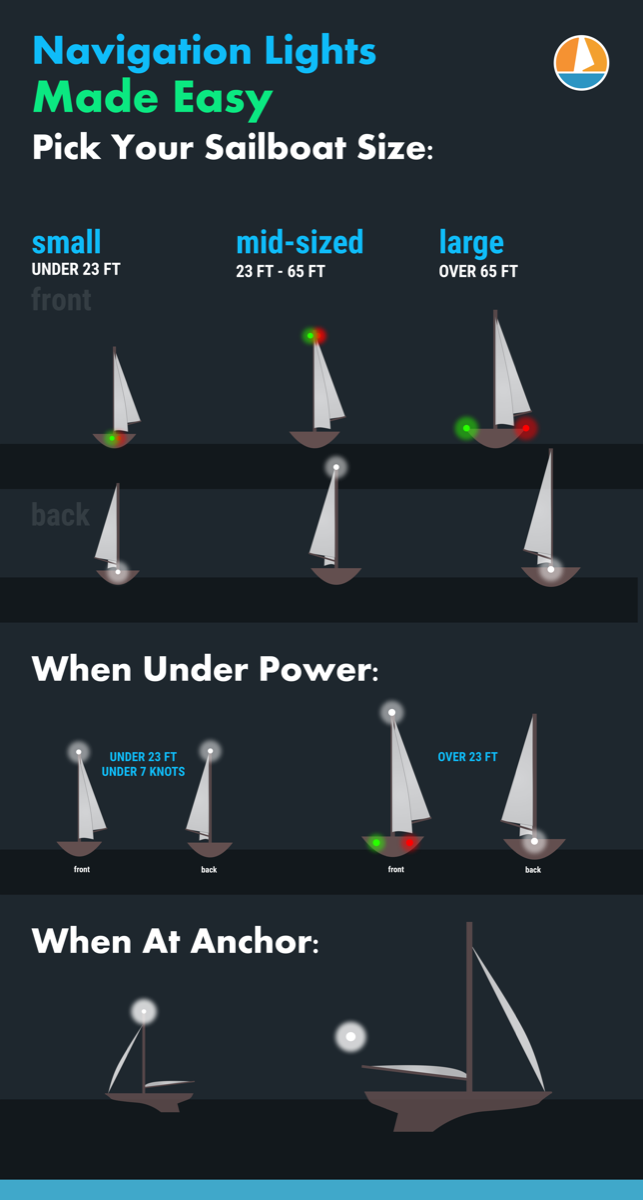
Leave a comment
You may also like, 17 sailboat types explained: how to recognize them.
Ever wondered what type of sailboat you're looking at? Identifying sailboats isn't hard, you just have to know what to look for. In this article, I'll help you.

The Ultimate Guide to Sail Types and Rigs (with Pictures)

Navigation Lights for Sailboats (And How To Read Them)

Last Updated by
Capt Chris German
June 15, 2022
Navigation lights on a sailboat can be confusing. If you understand the reason behind why they are the way they are however, they can make a lot more sense.
At their heart, sailboats are really just a power boat and as such must adhere to all power boat rules such as navigation lights. Other times however, a sailboat is classified in a special category. They have a set of additional lights they CAN show as an option, but are not always required to do so.
That’s about as clear as mud if you ask me and I contend that that is where the confusion about lighting a sailboat begins.
Just because you can show a light to identify yourself in times of low visibility, does not mean you have to and then we add in a little sibling rivalry between power and sail and things get downright adversarial when it comes to navigation and the night.
Table of contents
The USCG says You’re a Power Boat Whether You Like It or Not
Much to the consternation of many a sailor who has earned a commercial license to drive their sailboat, when you received your credential from the USCG it says you are a master of steam and power across the top with no mention of wind as a source of propulsion.
It is not until you read the back pages of your little red book that feels like a passport and looks like a US Sailing credential, that you will see the term “sail auxiliary”. That is because most of the time the U.S. Coast Guard knows that you are primarily reliant on your mechanical power to propel your vessel.
It's a sad thing, but the days of commercially viable sail boats are done and all but the most select few even have sails let alone use them as their primary power source. All sail boats by law are powerboats, but not all powerboats are sailboats.
Navigation Lights for a Power Boat
As a power boat, you are required to show certain lights and have been required to do so before power was even invented.
In the days of man powered vessels like the viking ships who relied on oars while in close quarters to power their vessels, they needed to show other boats, friend or foe, where they were by showing lanterns in the dark to identify themselves. As you know, it is a time honored rule among all the nations of the world both past and present, that you must avoid a collision at all costs while at sea and even the viking knew that you should not run into things.
By lighting the front and back of your boat, you could warn other boats of your presence as well as identify which way you were heading. As such there is a very specific rule in the Code of Federal Regulations Number 46 (CFR46 by common name) that spells out with detail how many, the color, the luminosity or brightness, the angle of visibility and the location of all of the lights required for navigation on every single boat, seaplane, submarine and other nondescript vessel conceived by man to date that they must show while underway in reduced visibility.
And there is no flexibility in the rules.
As such a power boat, and by extension all sailboats, MUST, without question show one green light on the starboard bow and one red light on the port bow and one all around white light or lights while operating in reduced visibility. These lights should shine at all 360 degrees of visibility with the bow lights shining at an angle of dead ahead to 22.5 degrees abaft the beam and the stern lights shining 225 degrees dead aft. A forward facing masthead light that is white in color shall shine forward to comply with the directive that all vessels must carry an all around white light. For more read here .
As you can see, there isn’t much wiggle room when it comes to lights that must be shown.
Sailboats get a little flexibility with lights
Sailboats however, are a little different when they are in fact sailboats, which is only when you are entirely reliant on the wind for power and in no way reliant on any mechanical or manual means of propulsion. And for good reason.
Back in the day when men were men and sailboats were wooden, fire was a major concern. Sails were coated with wax and other flammable substances and the wood on boats was saturated with oils and grease. Even the ropes were plant materials saturated with oils to keep them pliable and strong.
Add those highly flammable substances to a parching environment like the sea and you had what was essentially a giant floating tinderbox.
Then tell that giant floating tinderbox that they need to identify themselves to the world at large at night using oil lamps with flames because batteries and lights were not invented yet. It didn't take very long or very many ships burning to the water line for the Governments to say to the sailboats, you get to do things a little different.
As such, sailboats are given special dispensation when it comes to lights aloft. They don't have to show an all around white light in their rigging because no one wanted to set their rig on fire with oil lamps 60 feet up in their rig.
However, when a sailboat takes their sails down such as when they are powered or at anchor, they must resume the display of an all around white light or lights aloft. That became a real challenge with aluminum masts and the disappearance of rat lines on the shrouds because there was no easy way to climb the rig and check the bulbs up the mast on a regular basis.
Red over Green Sailing Machine
I have no idea where the history of this particular light comes from, but if you ever take a deck exam with the USCG, you better remember this mnemonic. An all around red light over an all around green may be displayed on a vessel during times of reduced visibility to indicate that a vessel is operating under sail power alone.
I won’t even speculate on how or why they came up with this particular light configuration, but if you want to use these lights as a sailing vessel, you can do so, but that means that you will need three all round lights at the top of your mast, an all around white, an all around red and an all around green, just in that order.
The red over green is to be displayed in addition to the running lights or the red and green bow lights with the 225 degree stern light. As always, when the motor comes on, so does the steaming light or the forward facing white light that is also usually about ¾ of the way up on your mast to complete the requirement of an all around white light that indicates a power vessel.
What is a “steaming light” and why are you mentioning it now?
Most sailboat electrical panels will have a switch that is labelled “steaming light” and it will only come on when your anchor light is off. This is probably the most confusing part of sailboat navigation lights so if you are confused about this, you're in good company as most people are.
A “steaming” light is named thusly, going back to the days of steam powered sailboats where when they fired up their boilers and doused the sails, they became a power boat once again. There aren’t too many steam powered boats, let alone steam powered sailboats, but the name stuck and it is a vestige of a bygone era.
Either way, when you fire up your motor, you turn on your “steaming light” and that locks out the all around white light which is used for anchoring to minimize the number of switches on your panel and reduce the number of wires in your mast. The fewer wires, the less chance of something not working or becoming disconnected.
The steaming light and the anchor light both go up the mast, but you can’t use an all around white light while using the 225 degree stern light at the deck level because to other boaters you would look like you have two white lights from the stern and that would be confusing.
The anchor light is used exclusively for anchoring while the steaming light is used to indicate you are a power vessel while underway.
As to why I am mentioning it now in the article, is because this would have blown your mind if I started with this subject cause it can be really confusing stuff.
Aspect Recognition with Lights
Remember when I said earlier that lights can help you tell others which way you are heading as well as tell you which way other boats are heading? That is called the aspect of the vessel and the USCG tests you on this for your deck exam as well.
Knowing that the bow lights go 22.5 degrees abaft the beam on both sides or 112.5 degrees on each side, and the stern light faces 225 degrees aft for a total of 360 degrees of visibility, you can tell a lot about where a boat is heading and who has the right of way.
One thing that's easy to remember is red means stop and if you see a vessel's red light, it means stop as you are the give way vessel and approaching the other vessel from his port side. Conversely it works with green as well as that means you are approaching from the other vessel's starboard side and you are the standon vessel.
If you see a red and green light equally low on the horizon, that means your heading dead on into another vessel's path and conversely if all you see is a white light low on the horizon, it means you are overtaking another vessel power or sail, we don’t care because it is an overtaking situation. However, any time you do see a white light aloft in addition to the red and green bow lights, you know you are encountering a power boat.
Then there are angular approaches as well, where you see white and red or white and green light low on the horizon. You know in that case you are seeing a portion of the bow lights and stern lights from the side approaches of a vessel. Based on which direction those lights are heading, you can deduce which way that boat is going in relation to your boat.
So put it all together and you see a green light and a white light low on the horizon with a red over green light aloft, you know that you are approaching a sailboat that is traveling to your port and that might make you the standon vessel. That is of course, if we didn’t concern ourselves with windward and leeward and port tacks and starboard tacks, but that is a discussion for another article. So stay tuned when we talk about sailing rules and the right of way. But for now, do good, have fun and sail far.
Related Articles
Capt Chris German is a life long sailor and licensed captain who has taught thousands to sail over the last 20 years. In 2007, he founded a US Sailing-based community sailing school in Bridgeport, CT for inner city youth and families. When Hurricane Sandy forced him to abandon those efforts, he moved to North Carolina where he set out to share this love for broadcasting and sailing with a growing web-based television audience through The Charted Life Television Network.
by this author

Most Recent

What Does "Sailing By The Lee" Mean?
Daniel Wade
October 3, 2023

The Best Sailing Schools And Programs: Reviews & Ratings
September 26, 2023
Important Legal Info
Lifeofsailing.com is a participant in the Amazon Services LLC Associates Program, an affiliate advertising program designed to provide a means for sites to earn advertising fees by advertising and linking to Amazon. This site also participates in other affiliate programs and is compensated for referring traffic and business to these companies.
Similar Posts

How To Choose The Right Sailing Instructor
August 16, 2023

Cost To Sail Around The World
May 16, 2023

How To Drive A Pontoon Boat
Jacob Collier
December 19, 2022
Popular Posts

Best Liveaboard Catamaran Sailboats
December 28, 2023

Can a Novice Sail Around the World?
Elizabeth O'Malley

4 Best Electric Outboard Motors

How Long Did It Take The Vikings To Sail To England?

10 Best Sailboat Brands (And Why)
December 20, 2023

7 Best Places To Liveaboard A Sailboat
Get the best sailing content.
Top Rated Posts
Lifeofsailing.com is a participant in the Amazon Services LLC Associates Program, an affiliate advertising program designed to provide a means for sites to earn advertising fees by advertising and linking to Amazon. This site also participates in other affiliate programs and is compensated for referring traffic and business to these companies. (866) 342-SAIL
© 2024 Life of Sailing Email: [email protected] Address: 11816 Inwood Rd #3024 Dallas, TX 75244 Disclaimer Privacy Policy

Navigation Lights
- You are required to display the appropriate lights at night or during times of reduced visibility.
Navigation lights are used to prevent collisions at night or in times of reduced visibility, and are an essential tool in keeping you and your vessel safe. Nav lights allow you to see other nearby vessels, and allow other vessels to see you.
Nav lights also provide information about the size, activity, and direction of travel. By understanding the characteristics of Nav lights, you can determine an appropriate course of action as you approach another vessel.
On any vessel, navigation lights have a specific color, (white, red, green, yellow, blue), arc of illumination, range of visibility, and location, as required by law and regulations. For the purposes of this course, we will concentrate on pleasure boats under 65 feet in length. Knowledge of navigation lights is important to a small-boat skipper for separate, but important, reasons.
- You are legally responsible for displaying lights of the proper color, intensity, location and visibility on your boat.
- Knowing the type and heading of another boat.
Legal Requirements
Vessels are required to show the proper navigation lights from sunset to sunrise in all weather conditions, good and bad. During these times, no other lights that could be mistaken for lights specified in the Rules of the Road can be displayed, nor any lights that impair the visibility or distinctive character of navigation lights, or interfere with the keeping of a proper lookout. The Rules also state that navigation lights must be shown in conditions of reduced visibility, and may be shown at other times considered necessary.
It's Your Responsibility
It is the responsibility of the owner/operator of a vessel that she show the proper navigation lights for her size and the waters in which she is operating. It is not the responsibility of the manufacturer, importer, or selling dealer. Many boats are delivered with lights that do not meet legal requirements with respect to technical characteristics or placement on the vessel. Remember also, that the angles of visibility must be met when the boat is underway-if your boat rides at a significant bow-up angle, take that into consideration when installing and/or checking your lights.
Navigation Lights for Powerboats
Power driven vessels underway shall exhibit a masthead light forward, sidelights and a stern light. Vessels less than 12 meters in length may exhibit an all around white light and side lights. Power driven boats on the Great Lakes may carry an all around white light in stead of a second masthead light and stern light combination.

Sidelights - Colored lights - red on port and green on starboard - showing an unbroken arc of the horizon of 112.5 degrees, from dead ahead to 22.5 degrees abaft the beam on each side.
Combination lights - Sidelights may be combined in a single fixture carried at the centerline of the vessel.
Stern light - A white light showing over an unbroken arc of the horizon of 135 degrees, centered on dead astern.
Navigation Lights for Sailing
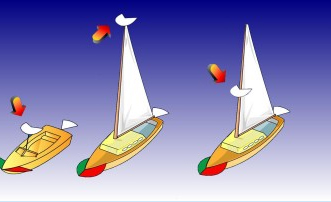
A sailing vessel of less than 7 meters in length shall, if practicable, exhibit regular navigation lights, but if not practical, she shall have ready at hand an electric torch or lantern showing a white light which shall be exhibited in sufficient time to prevent collision.
Diving Lights
Another light display that you may see in resort areas, or waters that have wrecks or reefs, is the night diving configuration. This has three vertical masthead lights, that have a red-white-red sequence. You must maintain a good distance from these vessels, and you should also be aware that there may be divers near you.
Interpreting what you see

It's great that you're learning the basics of lights - what is required and when they're required. But, this in only the beginning. You must also learn how to interpret the navigation lights that you see when you are underway at night- and for your safety-learn it well.
For instance, if you see a vessel approaching that shows a light pattern such as the ones to the right, you immediately know that you are in a crossing situation, and that you must yield to the other vessel - that's why it is red.

Seeing a green light over a white light indicates a fishing vessel actively trawling. You not only need to avoid the vessel, but you also need to remember that it could potentially have a very large net deployed that you will also need to avoid.
And there are numerous other lights and combinations of lights that you must be able to instantly recognize - the lights for a sailboat that is privileged over a motorboat, the special lights of various fishing vessels, a dredge or a vessel not under command. Study the requirements for navigation from the viewpoint of a "looker" as well as a boat owner.

Boat Navigation Lights: Everything You NEED to Know (2024)
In many cases, boating at night requires the use of boat navigation lights, but boaters often have many questions about them.
They often wonder when they’re needed, what the requirements are for various locations and vessels, and more.
We’re going to do a deep dive into navigation lights for boat to see what you need on your boat, and when you need to use them.
Legal Requirements
Types of navigational lights, which navigation lights are required on my boat , operators responsibility , navigation lights .
On any vessel operating on or in US waters, there is a need for the operator to display navigation lights under certain circumstances. Their purpose is to make vessels aware of each other at night or in times of generally reduced visibility. This is incredibly important during times when you may not be able to see the craft itself.
Other than visibility, marine nav lights also help boat operators determine the size, direction of travel, and even the potential activity of another boat on the water. When an operator understands the type of information each light tells them, they will be better able to determine appropriate courses of action for potential situations.
Boat running lights are divided by location and color, and each of them has specific requirements with how they must be displayed and perceived. You are the one legally responsible for displaying proper nav lights on the boat, for displaying them at the proper times, and for understanding how to read them.
The US Coast Guard ’s legal navigation light requirements include guidelines for every aspect of light usage.
Their materials start by first defining the standard daily period during which they must be used, then they detail how many of each type of light is needed as well as where they are located. Each light also has constraints regarding its visible distance and the arc over which it can be seen.
In the US, the Coast Guard says that any powered vessel that is under 39.4ft., may operate with boat nav lights in as little as two positions, an all-round light at the stern, and a set of sidelights at the bow.
Vessels that are under 164ft. must have lights displayed in four positions, a stern light, a masthead light, and boat sidelights on both the port and starboard, near the bow.
The ship navigation lights also have minimum visibility distances, depending on the size of the craft. The minimum visibility for nav lights, even for small crafts, is one mile, with requirements that other lights on larger vessels be visible for up to 3 nautical miles.
Also read: Boating Rules and Etiquette On the Water
Boat lights come in 4 types, sidelights, stern light, masthead light, and all-round light. Lights only come in white, red, and green, and all have very specific jobs.
| White | Over fore and aft centerline of the boat | 2 miles | 5 miles | 225 degrees | |
| Red | On the port side, 22.5 degrees abaft the beam | 1 mile | 2 miles | 112.5 degrees | |
| Green | On the starboard side, 22.5 degrees abaft the beam | 1 mile | 2 miles | 112.5 degrees | |
| White | Near as possible to the stern | 2 miles | 2 miles | 135 degrees | |
| White, Yellow, Tricolor | N/A | 2 miles | 2 miles | 360 degrees | |
| Green, Red, White | Over fore and aft centerline of the boat | N/A | N/A | 360 degrees | |
| Two White Vertical, Three White Vertical | Over fore and aft centerline of the boat | 2 miles | 2 miles | 135 degrees | |
| Flashing Blue | Anywhere not interfering with other lights | 2 miles | N/A | 180-225 degrees |
Masthead Light
The masthead light is the white light located about ⅔ of the way up the mast, rather than at the top as you’d think. This boat bow light is required when using motor power at night. To be acceptable, the light must have an arc of 225° and needs to be seen from 2 miles away.
Large boats can have up to 3 mast lights. If your boat is shorter than 39 ft., all 2-3 white mast lights can be combined, utilizing one larger white light at the top of the mast.
Color : White ARC : 225 degrees Position : Front of boat
Port Sidelight
The boating lights located on the port side of the watercraft are red and mounted so that boats can see as they approach either head-on or from the left. This light helps tell if a boat is coming towards you or if it is pointing away. The phrase “red, right, returning” means that if you see a boat with their red navigation light on the right, they are facing your boat. The only time it is not needed is when your boat is anchored for the night .
Color : Red ARC : 122.5 degrees Position : Forward, left side
Starboard Sidelight
If you are to approach a boat from the front or right, you will see the green starboard sidelight. With an ARC of 122.5 degrees, approaching boats will be able to see yours easily.
This light helps tell you whether or not you have the right of way, which is important when it comes to keeping both you and your passengers safe. These are some of the front boat lights.
This light will often be combined with the port light, in small boat navigation lights. When out in the water, if you see the green light, that means it is safe for you to go, as you have the right of way.
Color : Green ARC : 122.5 degrees Position : Forward, right side.
The rear boat light is called the stern light. It is used to mark the rear of the boat. The operator can infer from only setting a boat stern light, that they are directly behind the vessel.
The stern light is white and is visible for an arc of 112.5 degrees on both the port and starboard sides, making a full arc of 225. Being able to see the red starboard side light as well as the stern light, should indicate the other vessel is traveling to the right from the perspective of the observer.
Color : White ARC : 225 degrees Position : Stern
All-Around Light
One of the boat night lights that is required when on your boat between sunset and sunrise is the all-around light. This light is intended to be seen from any point and helps to tell what direction a boat is moving. This light is also used when a boat is stopped or anchored.
This anchor light is required to have an ARC of 360 degrees and should be visible for two miles. The all-around light is white and it is located at the top of your boat’s mast for maximum visibility.
Color : White ARC : 360 degrees Position : Top of mast
Tricolor Light
A tricolor light is a sailboat mast light that has your three types of bow light in one convenient piece of equipment. They are for sailboats that are smaller than 65.6 feet long. The point of this sailboat light is to increase your nighttime visibility. They are mounted at the top of the mast, allowing larger boats to see yours better. They are not permitted to be used by any boats with a motor. The only type of boat that can utilize a tricolor light is a sailboat.
Color : White, red, green ARC : 360 degrees Position : Top of mast
Towing Light
These yellow lights are important, as they indicate to other watercraft that, not only is there another boat nearby but that they are also towing someone as well. The light must be positioned at the back of the boat, as close to the stern as possible. The goal is to avoid having anyone run into the boat that is being towed, as there may be no lights showing where that boat is located. The boat lighting requirements when towing state that both sidelights, a stern light, and masthead lights should also be displayed.
Color : Yellow ARC : 135 degrees Position : Over fore and aft centerline of the boat
Law Enforcement Light
Lights used by law enforcement on the water are flashing blue lights that can flash 120 times per minute or more. They can be used nearly anywhere that is convenient for the operator, provided they do not interfere with the function of the other lights.
This light may be displayed by any type of local law enforcement that is engaged in the course of their duty. This can apply to local, state, or federal police, as well as officials from wildlife and conservation departments, the Coast Guard, and more.
Color : Flashing Blue ARC : 180-225 degrees Position : Anywhere not interfering with other lights
Find your boat type below for the lineup of nav lights that you will need to safely operate after sunset and in other times of limited visibility.
Be sure you know which lights you will need to have on while underway, as well as at anchor or while towing. If you’re sailing, don’t forget that you are considered power-driven when using your motor.
Powerboat under 23 feet (7m)
Powerboats under 23 feet are required to have the following navigation lights displayed:
- One white masthead light visible for 2 miles
- One red & green sidelight visible for 1 mile
- One stern light visible for 2 miles
- One white, red, green, or yellow all-round light visible for 2 miles
Powerboat Under 39,4 feet (12m)
Powerboats under 39,4 feet are required to follow these boat light rules:
- One all-round light visible for 2 miles
Powerboat Over 39,4 feet (12m)
Powerboats over 39,4 feet are required to have the following navigation lights displayed:
- One white masthead light visible for 5 miles, unless less than 20 meters, then 3 miles
- One red & green sidelight visible for 2 miles
Powerboat 39,4 feet (12m) to 164 feet (50m)
Powerboats between 39,4 feet and 164 feet are required to have the following marine running lights displayed:
- One white masthead light visible for 6 miles
- One red & green sidelight visible for 3 miles
- One stern light visible for 3 miles
- One all-round light visible for 3 miles
Sailboat Under 23 feet (7m)
Sailboats under 23 feet are required to have the following sailing navigation lights displayed:
- One white stern light
- One white mast lantern positioned at or near the top of the mast where it can be easily seen from a distance
Note: if it is not practicable for the vessel to display the prescribed lights, one all-round white light can be used or a hand torch, with enough time to prevent a collision.
Sailboat Under 65,6 feet (20m)
Sailboats under 65,6 feet are required to have the following sailing lights displayed:
Tug Boat With Tow Length Under 656 feet (200m)
Tug boats with tow lengths less than 656 feet are required to have the following navigation lights displayed:
- Two masthead lights in a vertical line
- Stern light
- Towing light in a vertical line above the stern light
Tug Boat With Tow Length Over 656 feet (200m)
Tug boats with tow lengths longer than 656 feet are required to have the following navigation lights displayed:
- Three masthead lights in a vertical line
- A towing light placed vertically above the stern light
- A diamond shape visibly displayed
Anchored Vessel
Vessels at anchor or aground are required to observe the following boat lighting rules:
- One white all-round in the fore
- One white all-round at a lower level than the fore, at the stern
If aground, the vessel should display two red all-round lights in a vertical line
Vessel Under Oars
Vessels under oar power have similar requirements to follow as small sailboat lighting:
- One stern light
Or, alternately, one white all-round light or hand torch to be used to manually signal to avoid collision
Vessel Engaged in Fishing
Vessels actively engaged in fishing are required to have the following marine navigation lights displayed:
- Two all-round lights oriented in a vertical line, red on top and white on the bottom
- One all-round white light for gear more than 150 meters from the vessel
- When making its way through the water, there shall also be sidelights and stern light
Vessel Engaged in Trawling
Vessels engaged in trawling are required to fulfill the following boat light requirements:
- Two all-round lights oriented in a vertical line, green on top and white on the bottom
- One masthead light abaft and higher than the all-round green
Kayakers and Canoers
Kayakers and canoers are required to have the following navigation lights displayed:
Alternatively, a hand torch or lantern which can be used to signal to avoid collisions
Personal Watercraft
There are no established rules for navigation lights on personal watercraft, even though many of them are classified as a boat by coast guard standards. Personal watercraft are often not permitted to operate outside of the sunrise-to-sunset period, and so most manufacturers do not install or make possible the installation of navigation lights.
Vessels Restricted in their Ability to Maneuver
Vessels restricted in their ability to maneuver are required to have the following navigation lights displayed:
- Three all-round lights displayed as high a possible in a vertical line, red at the top, and white in the middle
- One masthead light
The USCG as well as state authorities hold the operator of the vessel responsible for the correct use and understanding of nav lights.
This means they also must make sure all of the lights used meet the requirements set forth by the authorities.
This also extends to ensuring that the lights are all installed for optimal visibility while underway, so if your cruiser rides high, make sure your lights are still visible.
What navigation lights do I need on my boat?
Boat light regulations state boats must have a pair of red and green sidelights, and an all-around white light that can be seen from 360°.
Why are navigation lights red and green?
Navigation lights for boats indicate to others which direction a boat is facing. The red indicates the left side of the boat, green is on the right.
What lights need to be on a boat at night?
Per the navigation lighting rules, it is crucial that you have your red and green navigation lights, as well as the white 360° light.
Which three colors are used for navigational lights?
The boat light colors are going to be green, red, and white. If you see a blue light, this generally indicates a government vessel.
Do I need navigational lights on my boat?
Yes, all boats are legally required to have the minimum red, green, and white boat safety lights
when operating in the dark.
Why do boats have blue lights?
When you see a boat that has blue boat lights at night, that means that it is likely the coast guard or law enforcement.
Why is port red and starboard green?
The light on the starboard side of the boat is green because it is ‘safe’, as the steersman will be able to see other boats.
What does a single white light mean on a boat at night?
If you can only see a single white light on a boat at nighttime, you are likely seeing the stern light or the boat anchor light.

Robert Owens is the Chief of Content of Quicknav. Robert has been boating for over ten years and loves to share his experience on the water. His first boat was a dirt-cheap moderately beat up 2003 Bayliner 175, where he learned a tremendous amount about trailering, launching, docking, operating, and maintaining. He currently owns a Cruiser Yacht and is eyeing a sailboat.
Similar Posts
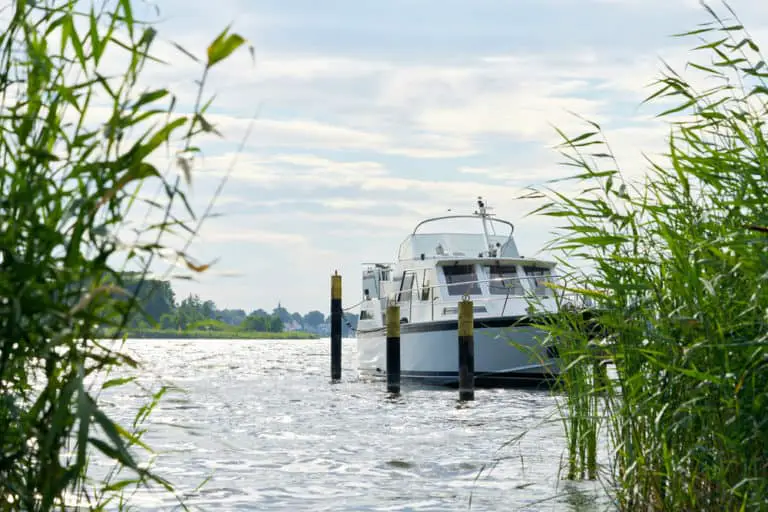
Do You Need a License to Drive a Boat in 2024? (U.S. & Canada)
It’s getting to be prime vacationing time, and if you’re traveling to enjoy some time on the water, you will…
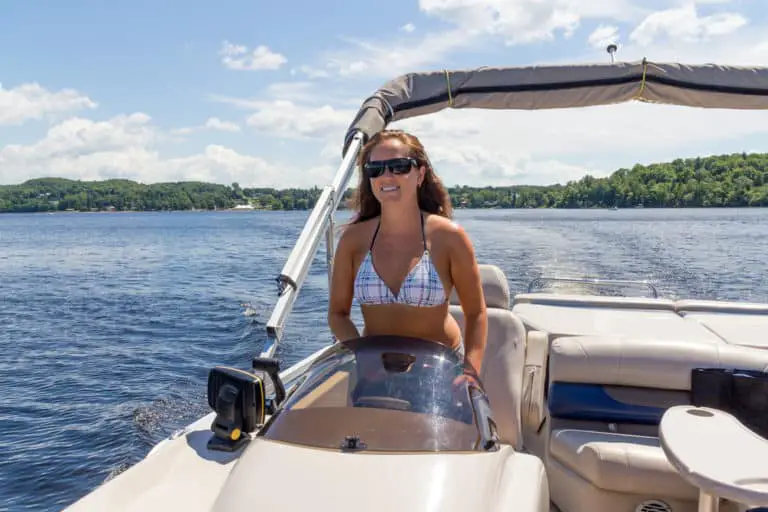
How to Drive a Boat? (Step-by-Step Guide)
Now that you have a boat, or are close to picking up that new toy, one major hurdle you will…
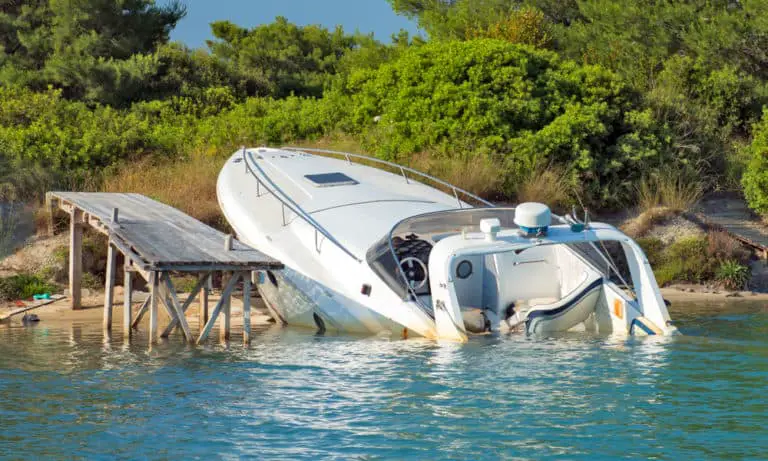
Boating Accident Statistics in 2024 (Latest U.S. Data)
Thanks to worldwide lockdowns and social distancing, we are seeing an increase in recreational boating and related accidents. Sadly, boating…
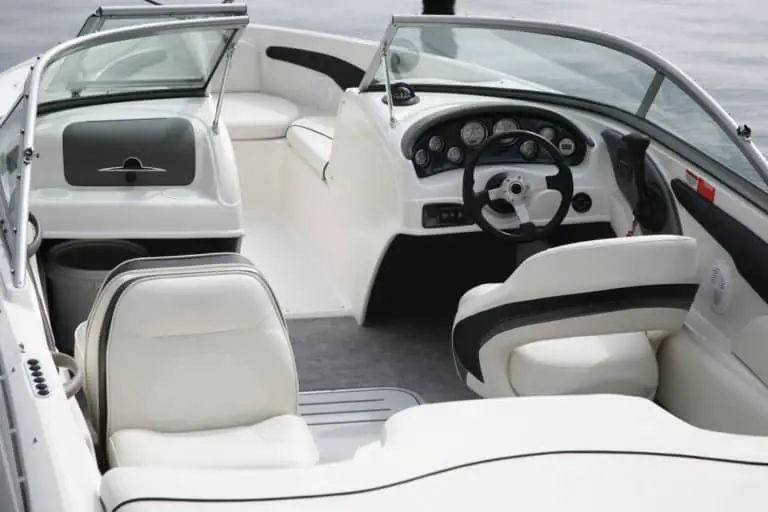
How to Clean Boat Seats? (a Practical Guide)
So you’ve bought your first boat and while you think you can master most of it with ease, you keep…
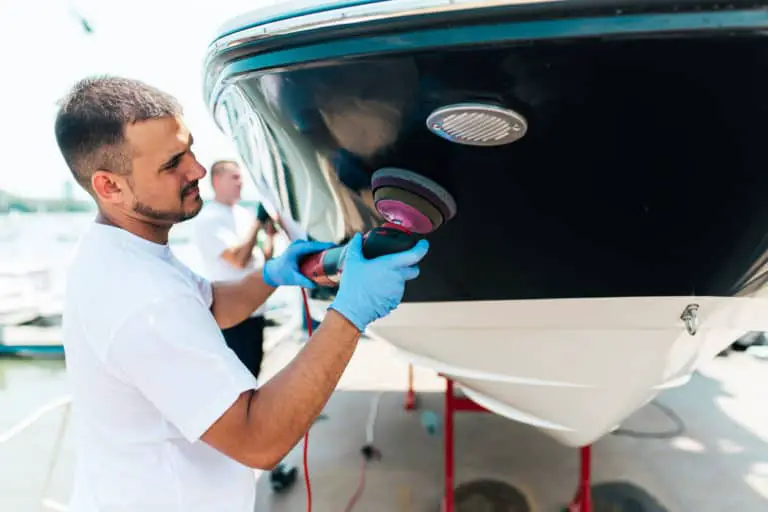
Boat Maintenance: The Definitive Guide (2024)
Many new boat owners are a little intimidated by the thought of the boat maintenance that they need to do….
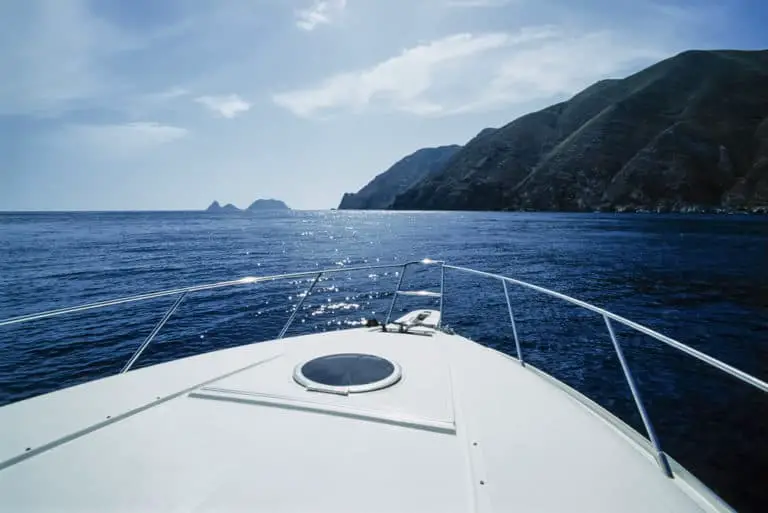
15 Practical Boating Tips for Beginners (2024)
Those new to the boating world as well as those who are simply new to owning their own boat may…

Please verify you are a human
Access to this page has been denied because we believe you are using automation tools to browse the website.
This may happen as a result of the following:
- Javascript is disabled or blocked by an extension (ad blockers for example)
- Your browser does not support cookies
Please make sure that Javascript and cookies are enabled on your browser and that you are not blocking them from loading.
Reference ID: 56f58dc2-5f6e-11ef-9fc5-d5e5f847e0fa
Powered by PerimeterX , Inc.
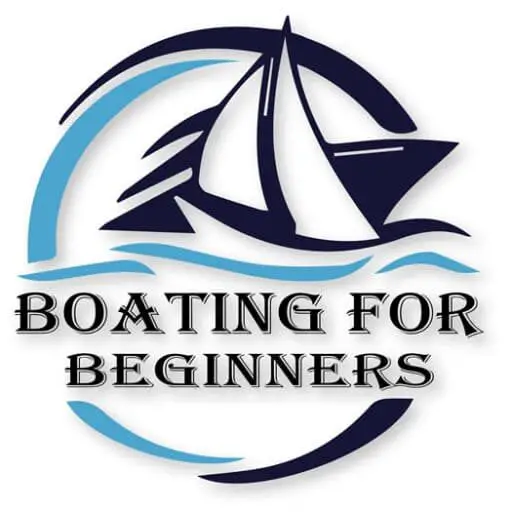
Boat Lighting – Complete Guide to Navigation Lights
I was sitting in the garage the other day admiring my boat when I noticed the green navigation light on the side of the hull, and it dawned on me that I haven’t had the boat out after sunset yet. It also got me wondering about the different places I’d like to travel this summer and what it would be like to navigate in the dark if I had to.
In addition to the legally required lights, I highly recommend having a marine waterproof spotlight in your boat at all times ( this is the one I prefer, which you can buy on Amazon with tons of good reviews ). The little headlight on a boat is nowhere near bright enough to safely navigate if you get caught on the water at night. Trust me, it can save you thousands in boat repairs and a dangerous situation.
I wanted to make sure that I fully understood everything there was to know about navigation lights, so I did some online research. I’ve put together a complete guide of the information I found online talking about the different navigation lights and what I needed to know about them.
What Are Navigation Lights On a Boat?
Boats require specific lighting configuration when operating between sunset and sunrise, or at times when visibility is restricted such as when it’s raining or foggy. Navigation lights are used to help other boaters see you when visibility is reduced, and it allows you also to see the other boaters to avoid collisions.
Navigation lights are also used to communicate with the other boats sharing the water. For example, the navigation lights can tell another boater, what size your vessel is, and in which direction you are heading. This information can be used by the boat caption to determine what the appropriate course of action would be as you approach each other.
By law, the navigation lights come in specific colors; white, red, and green. Even the arc of the illuminated light, the range of visibility, and the location is all specific to what type of vessel you are operating.
Do not assume that your boat came with the appropriate lighting or equipment from the factory or showroom. It is your responsibility to make sure that your boat has the proper navigation lighting configuration before you head out on the water.
What Type Of Boats Requires Navigation Lights?
Basically, in a nutshell, all boats require navigation lights if you’ll be operating them between sunset and sunrise, or whenever visibility is reduced.
This goes for the following types of vessels:
- Motorized vessels
- Non-motorized vessels
- Sailing vessels (Operating under sails)
- Sailing vessels (Operating under motor power)
- Vessels engaged in fishing
- Vessels engaged in trawling
- Towing vessels
- Anchored vessels
- Human-powered vessels such as Rowboats (Kayaks and canoes)
What Lights Are Required On a Boat?
Boats are required to have navigation lights. Navigation lights are required whenever you are operating your vessel between sunset and sunrise, or during any other times when your visibility is restricted from elements such as fog or rain.
The type of lights required depends on the length of your vessel as well as if it’s a powered or non-powered vessel. But in general, all navigation lighting systems will consist of red and green sidelights, as well as one or more white lights. A red sidelight indicates the port side of the vessel, while a green light shows the starboard side of the vessel. The white light in most cases is called an all-around light, which means it can be seen from any angle by other boaters.
Another type of navigation light is a yellow light. A yellow light is not very common to see, but if you do happen to see one, it would mean that a lead boat is towing another boat.
It is your responsibility to make sure you have the proper navigation lighting. It is also recommended that you take spare bulbs with you. The USCG doesn’t care if the lights were working when you left, they only care that the lights are not working when they are required.
Lights Required For Power Vessels Underway:
A powered vessel includes all motorized boats, including sailboats that use a motor.
Vessel length: Under 12 meters (39.4 FT.) Lighting requirement:
- One all-around white light that is visible at 360 degrees, and can be seen from two miles away. The all-around white light must be mounted at least 39 inches above the side lights.
- A pair of red and green sidelights that are visible 112.5 degrees and can be seen at least one mile away.
Vessel length: 12 meters to 20 meters (39.4 FT. to 65.6 FT.) Lighting requirement:
- A white masthead light located at the front of the boat, pointing in the direction you are traveling. This must be visible at 225 degrees and from two miles away. The masthead light must be positioned at least 8 feet above the gunnel.
- A white stern light located at the rear of the boat that is visible at 135 degrees and can be seen from 2 miles away.
Lights Required For Non-powered Vessels Underway:
A non-powered vessel includes sailing vessels and all other types of vessels that don’t have motors such as paddled, poled, or rowed.
Vessel length: Under 7 meters (23 FT.) Lighting requirement:
- You are required to display a white light that can be seen by other boats. White light could consist of a flashlight, torchlight, or lantern.
- If you can, it is recommended that you have an onboard 360-degree white light all-around set on the horizon, with a distance of at least two miles.
Vessel length: Over 7 meters (23 FT.) – NEED 3 IMAGES Lighting requirement:
- A pair of red and green sidelights, that are visible 112.5 degrees and can be seen at least one mile away.
- Alternatively, for sailboats of that are over 7 meters in length, they can display what is called a tricolor light A tricolor light can only be used while the vessel is underway using sails alone and never while underway by power. This light should also never be used at the same time that the regular sidelights are on. Either the tricolor light or sidelights can be displayed, but never both.
Lights Required For Vessels At Anchor (Less Than 50 Meters):
This rule applies if you are anchored away from a designated area such as a marina.
Vessel length: 12 meters to 20 meters (39.4 FT. to 65.6 FT.) Lighting requirement:
- White all-around light is required to be used so you are visible to other ships that could be in the area.
Due to variances in state boating laws/regulations, NASBLA does not provide state-specific information. You may contact your state boating office for the most accurate information. Contact information can be found here: https://www.nasbla.org/about-nasbla/boating-contacts .
Understanding The Difference Between Port And Starboard Lights
While standing on the deck and facing the front of the ship, the left side is called the Port and the right side is called the Starboard. The port is always red , while the starboard is always green .
This information is crucial to understand if you ever find yourself trying to navigate the waters at night or while your visibility is limited. For example, if you are sailing towards another vessel, you will be able to tell if that vessel is heading towards you, or if it is heading away from you based on which side the green and red lights appear to you.
If you see a red light coming towards you, that would mean the other boat is on your right, which means that boat would have the right of way. If you see a green light from an oncoming vessel than you would know that it’s on your left, which means you have the right of way.
When Should Navigation Lights Be Displayed On a Boat?
Navigation lights are required to be displayed in between sunset and sunrise, and anytime that visibility is restricted. For example, due to fog or rain.
Where Can You Buy Navigation Lights?
As discussed earlier, not all boats automatically come with the proper display of navigation lights. It is your responsibility to ensure that your boat has all of the proper equipment for your safety and the safety of others.
The prices for navigation lights will vary anywhere between $9.00 to $100.00 depending on what style and manufacturer you buy. You could even spend as much as $500.00 on some of the higher-end navigation lightings. Be sure to shop around and take a look at what is available, to ensure that you are finding the best lights, at the best prices.
Definitions
All-Round Light: White (32pt/ 360°) Masthead Light: White (20pt/ 225°) Sidelights: Red (10pt/ 112.5°) & Green (10pt/ 112.5°) Stern Light: White (12pt/ 135°)
Similar Posts

Nautical Terms – Boating Words Every Sailor Should Know
What Are Nautical Terms? I can still remember going on a boat trip with a friend who was a sailor and a boat expert. He kept mentioning these strange words to his assistant while trying to control the boat. I had almost lost my interest in sailing until my friend walked over and had to…

Helpful Tips For Towing a Boat
Every boat owner knows that being able to take your boat everywhere you want is a privilege and a great way to spend your time. However, there are specific rules you have to abide when you want to tow a boat. Some states require special trailer brakes especially if the boat has more than the…
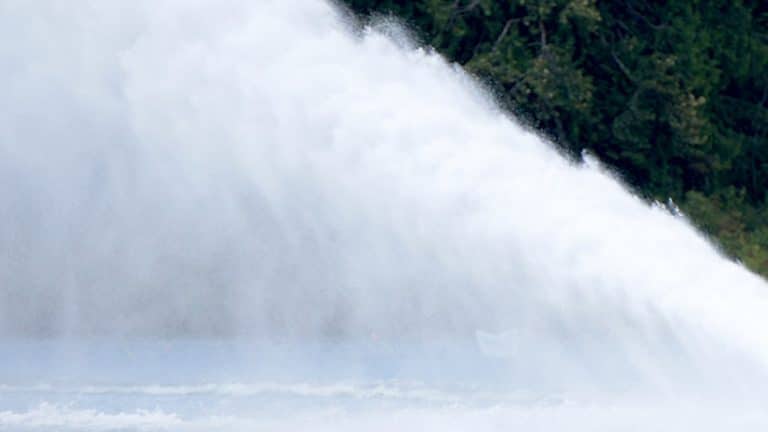
What Is a Boat Rooster Tail and How You Can Make One
The term rooster tail is used in fluid dynamics, meteorology, and automotive gear shifting. But in this article, we are going to talk about rooster tail related to fluid dynamics. In fluid dynamics, a rooster tail lies directly in the wake of an object such as a boat traveling within the water and is accompanied…
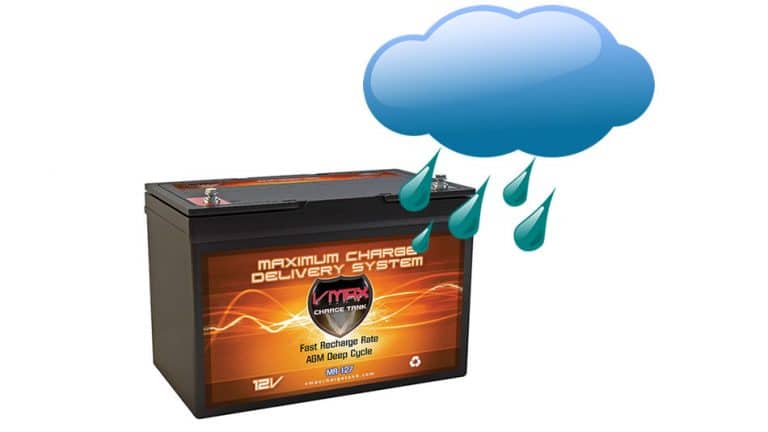
Can a Boat Battery Get Wet
I was sitting here thinking about my batteries that I have stored on my basement floor for the winter and it got me wondering if the batteries could get wet if my sump pump stopped working and the basement flooded. Marine batteries can get wet, but water can corrode the terminals, so should be dried…
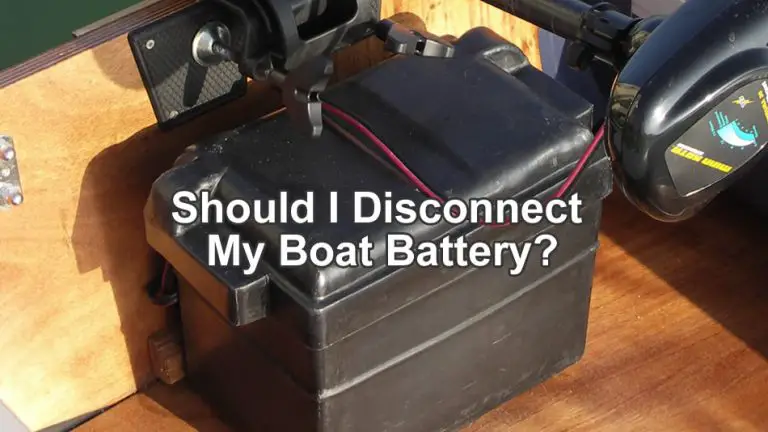
Should I Disconnect My Boat Battery – What I Learned
One of the questions that I have asked myself was whether or not I should be disconnecting the battery while my boat is not in use. What I found out was that, yes, you should disconnect the battery if your boat is stored on land, but if you store your boat in the water, then…
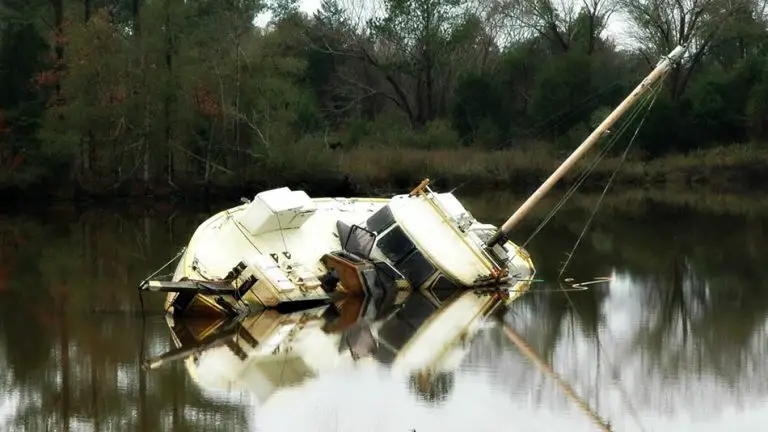
What Causes a Boat to Sink and What You Should Know
There’s no worst feeling than walking down to the docks with your fishing pole in hand, only to find your boat is now sitting at the bottom of the water. There are many different ways for your boat to sink. The most common way for a boat to sink is from a faulty bilge pump…
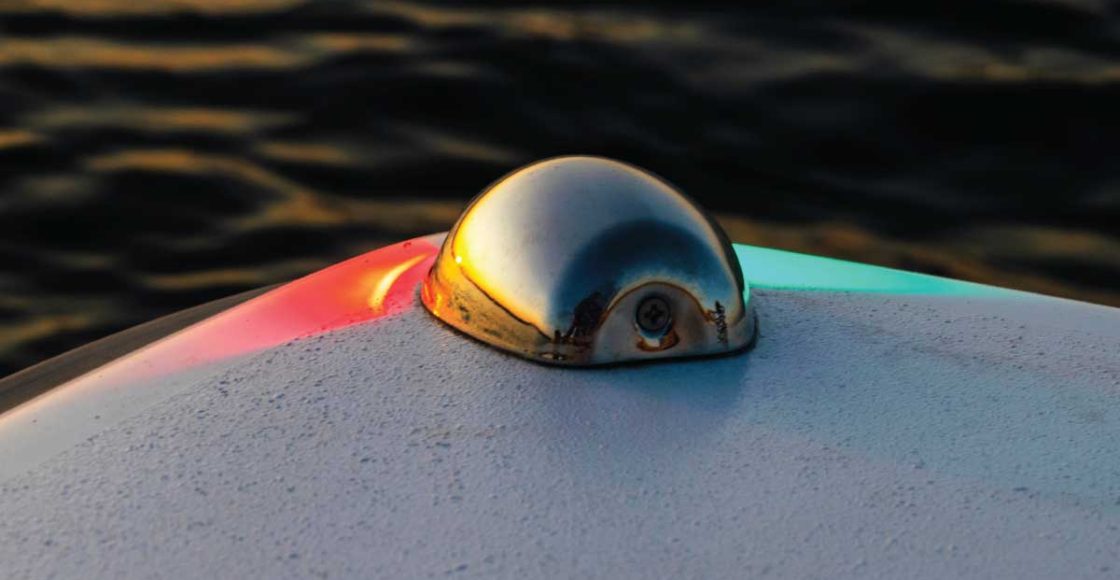
Boat Navigation Lights: Understanding the Basics

Table of Contents
Last Updated on July 19, 2022 by Boatsetter Team
For many boaters, the best way to end a beautiful day on the water is to watch the sun slowly drop below the horizon while it lights up the clouds and sky above. Others feel better heading to the dock before the sun goes down, while there is still plenty of light to illuminate the channel markers and other potential dangers.
Besides understanding boat navigation light rules, it is also important to understand:
- The overall purpose of boat navigation lights
- How to properly use boat navigation lights
- What the different colors (red and green) mean
Own a boat? Earn an avg. of $20K per season renting it out on Boatsetter
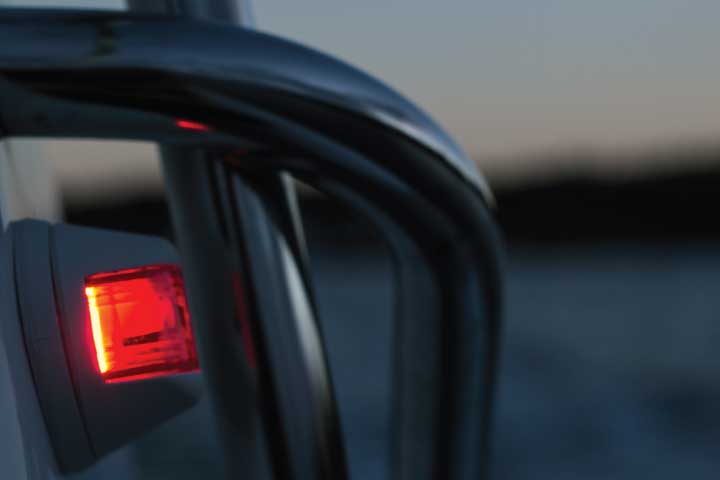
How do boat navigation lights work?
Boat navigation lights, or “nav lights,” are the colored marker lights visible on either side of the vessel and at the stern . These lights play essential roles in identifying the ship’s length, direction, and purpose!
The colored marker lights and where to find them go as follows:
- The boat’s port side is marked with a red light.
- The starboard side light is green.
- When looking at the boat’s transom or stern, a white light may be visible.
Keep in mind large boats and ships may use other colors, like yellow.
Next time you’re boating at night , say thanks to your navigation lights. They allow you to see other boaters in the dark and help prevent collisions. But there is much more to boat navigation lights than that.
How to use boat navigation lights
Each of the boat’s navigation lights is only visible for so many degrees of a circle to prevent confusion and accurately identify which side is in view.
By noting which colors are visible on another vessel, boaters can identify which direction the other boat is facing or headed. Knowing a boat’s direction can be especially important when crossing paths with another vessel in the dark.
If you walked around a boat at night while the navigation lights were on, the color visible would change depending on where you stood. When looking at the port side of the boat, the red light would be visible from dead ahead of the vessel to just past the center of the port side or through 112.5 degrees of a circle. Walk to the starboard side, and the green light would be visible from the bow to just past the boat’s center, or another 112.5 degrees.
Stand at the back of the boat, and you will see the white light visible for a total of 135 degrees from one side of the vessel to the other. Add up all three, and you’ll get 360 degrees.
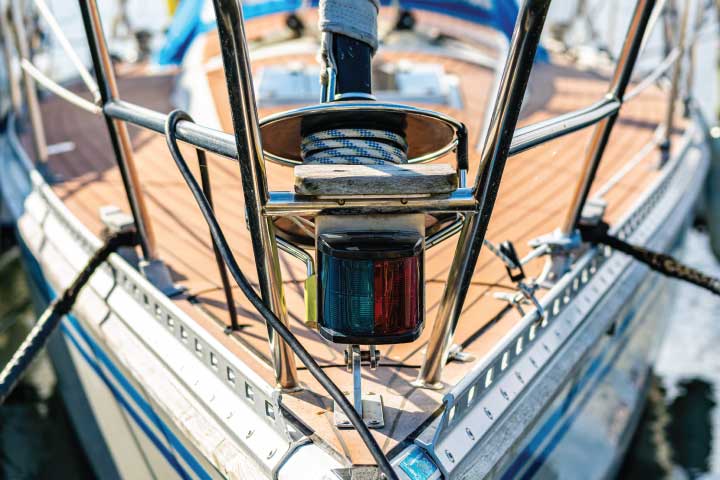
Boat navigation light color meanings
If you were on a boat at night and could see nothing but the different colored lights of another vessel ahead of you, you would still know exactly which way that boat was going.
- If you could only see the red light ahead of you, you would know that you are seeing the other vessel’s port side, or it is crossing in front of you from your right to left.
- The opposite is true if you saw the other vessel’s green light . You would be looking at the other vessel’s starboard side or watching the boat pass in front of you from left to right.
- If you see both red and green lights , then the other vessel is coming straight at you if you can see both red and green lights.
- If you can only see the white light and nothing else, you would look directly at the other boat’s stern as it drives away.
- Red and white means the boat is driving away from you, crossing from right to left.
- On the other hand, green and white signal that the vessel is moving away from you, crossing from left to right.
When renting a boat on Boatsetter , make it a habit of checking that navigation lights are working. You should turn on the navigation lights even if the sun is out. It’s the best and safest boating practice.
Want additional resources for boating?
Check out the links below for more information on boating.
- Navigation lights study guide
- Pre-departure boating checklist
- Boat Spring Commissioning Dewinterization Checklist
Don’t let your boat sit idly by. List it with us to earn $20K on avg.

Chuck Warren fell in love with boats at 9 years old while helping to restore his grandfather’s 1939 44-foot Elco cruiser. A lifelong boater, Chuck has experience operating large and small vessels on the waters of the Atlantic, Gulf of Mexico, Caribbean, and the Great Lakes.
During his 35-year marine industry career, Chuck has been the driver for several offshore powerboat racing teams, the chief engineer aboard a Caribbean research and salvage vessel, captain of a Florida Keys sunset cruise, and more.
Today, Chuck is a boating industry writer, copywriter, and captain who lives on his 40-foot boat in the summer when he isn’t delivering vessels around the Great Lakes or teaching new boaters to drive. Winters are split between the West Michigan lakeshore and wherever his travels take him.
Browse by experience

Explore articles

8 Boating Apps No Captain Should Be Without
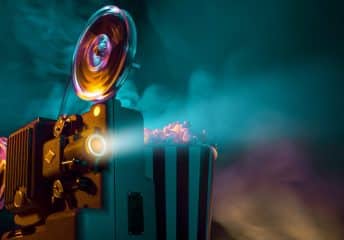
Navigating Cinematic Waters: 10 Must-See Movies Set Afloat
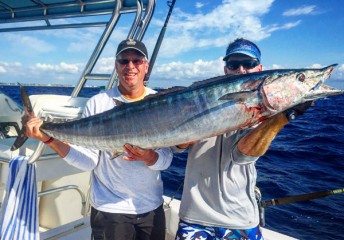
5 Things Football and Fishing Have In Common
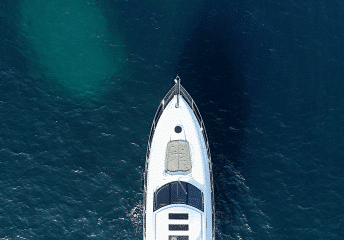
Sunseeker Yachts: The Complete Guide to Sunseeker Yachts

Ultimate Guide To Marine Navigation Lighting
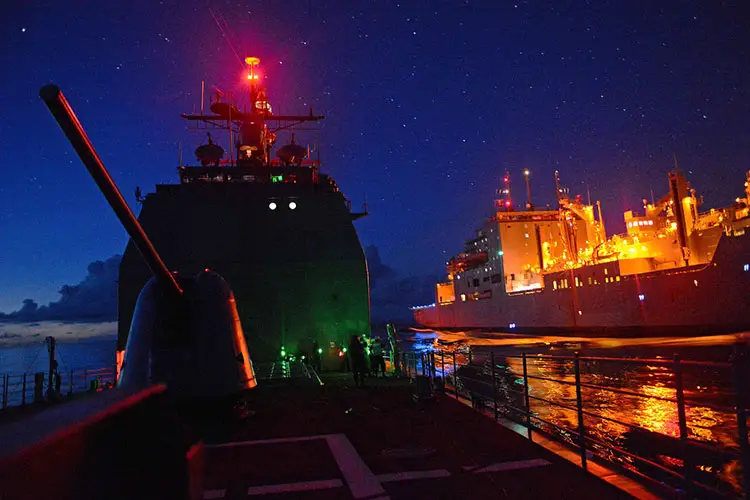
If you drive a car or even ride a bicycle, you might be well aware of the necessity of lighting systems (though in the second case the word ‘system’ doesn’t quite apply) for the safety of you and the people around you. The thing applies just as well for ships. But since they are much larger than a car, the lighting system or navigation lights on ships is a little bit more complicated as well. Marine navigation lighting is also one of the most critical aspects of nautical studies.
It is mandatory for boats of all sizes to have a navigation system . This is to make sure that the chances of any significant accident are minimized. The United States introduced the system in 1838, and the United Kingdom followed suit. Before being internationally adopted in 1897 suitable guidelines were established by the International Maritime Conference which was established in 1889. Three colors were chosen that were to be used for the light colors. They were red, green and white. This was based on a set of rules specified by the US and are followed around the world to this date.
This article discusses the different rules and regulations of using navigation lights, their importance, and also some basic marine navigation lighting systems along with their positions and ranges.
Marine Navigational Lights, Rules and Regulations
A standard pattern of marine navigation lighting is followed for the identification of both the vessel as well as the IALA buoyage system at night. If you are required to move from sea to a channel you need to have a list of all the IALA as well as the other fixed navigational lights that are visible on entering the channel. This includes distant lighthouses as well.
If you also make a note of the inland features like the radio and television transmitter masts it will benefit you because they act as good navigational aids due to their height and warning lights.
The helmsman should not be using any bright light source in the cockpit area and should rather take the aid of red lights and very dim white lights in the galley and navigation area. This is because he needs to preserve his night vision so that he can accurately interpret both the buoyage marine navigation lights as well as the boat navigation lights of other vessels.
The nautical almanacs contain the details of each and every visible maritime light signal coming from navigational markers that are both inside and outside the channel.
All the details about any particular light can be found in a published list or on a marine navigational lights chart: its color, period, and in some cases even the elevation and range of the beacon. Use the chart to keep a tag on the lights you are passing by putting a tick mark on the lights that you are about to pass and as the boat sails past, the tick is checked.
You will get two visual clues to figure out how far you are away from a buoy. The light will elevate from the horizon at 0.5 nm and at about 200m, the light will reflect on the surface.
Position of Boat Navigation Lights
Most of the variations that can be found in the different vessels can be read about in most almanacs. At the very basic level, a vessel needs to show a red light to port and green light to starboard. Depending on the size of the vessel, one or more colored or white lights are used as well.
For vessels that are 12 ft in length or shorter, the navigation lights must be visible from a range of one nautical mile and for the ones that are longer than 12 meters the required visibility range is 2 nautical miles. From 5 degrees above to 5 degrees below the horizontal happens to be the required minimum intensity in a vertical sector.
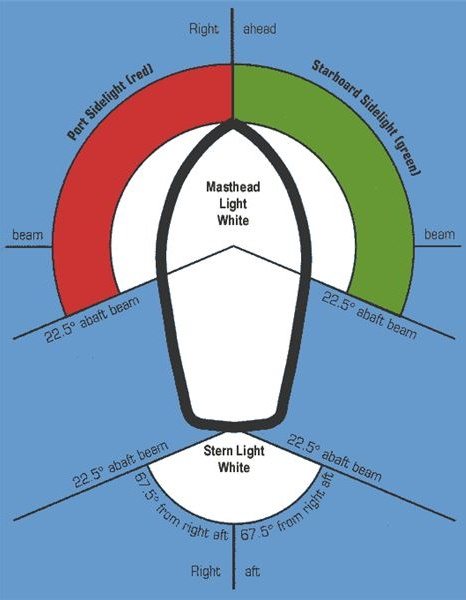
International Navigation Rules state that the boat navigation lights should be placed above the uppermost continuous deck. In case separate fixtures are used for the red and green sidelights, the masthead or all-round white light is placed as close as possible to the vessel’s fore and aft centerline. The masthead or all-around light needs to be positioned at least 1 m or 3.3 ft above the sidelights.
Following are the basic positions of navigational lights. We will discuss the same in greater detail ahead.
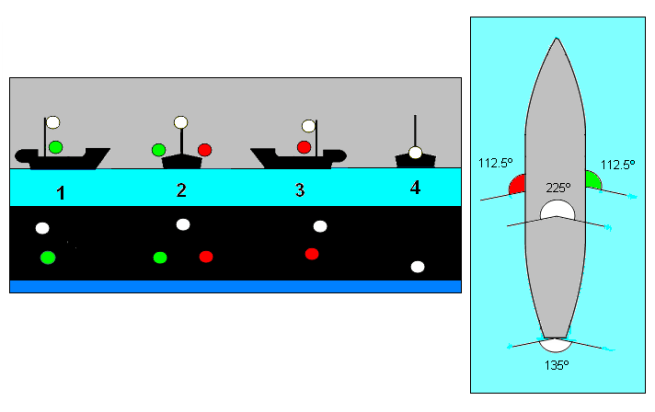
Also read: What Is A Marine Sextant?
Boat Navigation Light Regulations
Several rules and specifications are related to the type, size, layout, arc, and distance of visibility of boat navigation lights used by all vessel types which are collectively known as the International Regulations for Preventing Collisions at Sea or COLREGs . The navigational lights used are known as ‘COLREG lights and shapes. A boat might be anchored or underway, under sail or power, or fishing or trawling. These various situations can be communicated through multiple combinations of boat navigational lights.
In addition to the primary navigation lights, vessels may also display one or more steaming lights. These lights are very useful for it gives details about the various aspects of the ship like whether it is in the sail or under power, the direction in which it is going and, in some cases, even the size of the vessel. If a ship is engaged in a specific task that might involve certain restrictions, that too can be indicated with some extra boat lights.
Always maintain the lighting system and display the correct navigation light combination to make other vessels in the vicinity aware of your course and state as to whether your vessel is under power or not. If you follow this a considerable amount lowers the chances of a collision. Here is a list that you might use to familiarise yourself with the basics of the lighting system.
- Basic Navigation Light White Light : Small dinghies that are 7m or less in size are required to carry a torch having a white light that can be flashed when needed.
- All-Round White Light: An all-round white light is expected to be displayed by a small boat, up to 7ft long that is under power and can go beyond 7 knots of speed. This light must be visible at an angle of 360 degrees and from two miles away. An all-around white light is also used when the boat or vessel is at anchor but not at a designated anchoring area. This is to make sure that the ship is visible to all the nearby ships to avoid any accidents.
- Stern and Combined Side Lights : A stern light is a white light that is installed at the end of a boat. A vessel that is over 7 m or 23 ft in length is expected to show red and green sidelights when sailing. Each of these lights needs to cover an arc of 112.5°. The sidelights may be combined in one lantern at the bow when below 25 m or 65 ft. The white stern light can be seen over an arc of 135°. These lights need to be visible from a distance of a mile and need to be placed 39 inches below all white lights for boats of lengths equal to or less than 12 ft.
- Masthead Light : A combination of sidelight and stern light in a tricolor combination may be used sailing yachts of heights 20 m or lower. A masthead light is required by vessels of lengths between 39.4 ft and 65.6 ft. It is placed in the masthead whose height provides excellent visibility. Still, stern lights and sidelights should be fitted separately in case of or use under power along with steaming light. This kind of light needs to be visible across an angle of 225 degrees and from a minimum distance of 2 miles.
- Separate Lights : The displaying of the tricolor masthead light is not allowed in the case of yachts that are longer than 20 m or 65 ft. Instead, they use them separately. Often on large sailing vessels, these all-around, red over green lights are present. These red and green sidelights need to be visible from a distance of one mile and across an angle of 112.5 degrees.
- Steaming Lights Combined Lights : A combination of the masthead and stern light are used in the case of power crafts that are less than 20 m or 65 ft in length. The arrangement is present at the bow.
- Single Steaming Light : Visible over a 225 degrees arc, a masthead steaming light is used by power-driven vessels that are up to 50 m or 160 ft long. Separate stern lights and sidelights are used in case of a length exceeding 20 m or 65 ft.
- Two Steaming Lights: Power-driven vessels that span over 50 m or 160 ft in length display two masthead steaming lights. The forward light placed lower than the aft light with both of them being visible over an arc of 225° with the sidelights and separate stern light.
The area of the nautical lighting system is a precise business and requires some amount of study and a good deal of responsibility. It is because its application forms a core element in safe marine navigation.
Similar Posts
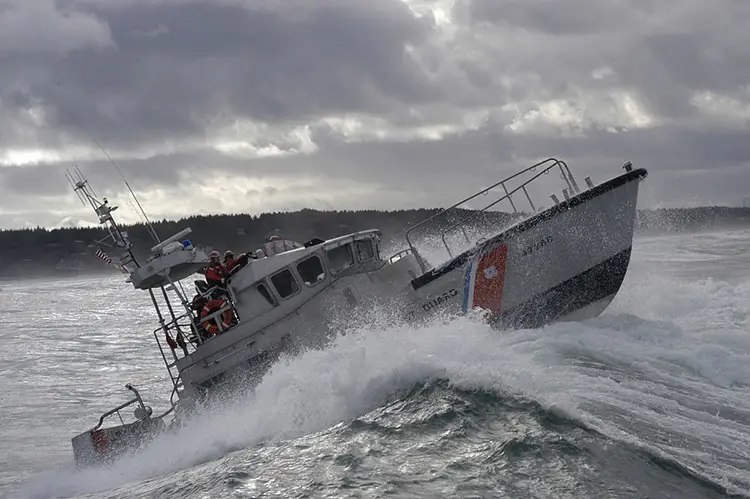
Types Of Ship Vibrations – Hull Vibrations & Machinery Vibrations
Vibration in ships not only causes structural fatigue but also ruins the experience of the passengers as well as the crew due to discomfort. As a result, many of the ships are discarded if they cause too much vibration. It is because vibration in ships may indicate that there is something wrong with the functioning…
![Straddle Carriers [ULTIMATE GUIDE] 5 Straddle Carriers [ULTIMATE GUIDE]](https://www.maritimemanual.com/wp-content/uploads/2021/07/straddle_carrier.jpg)
Straddle Carriers [ULTIMATE GUIDE]
A straddle carrier or also known as a straddle truck is a lifting apparatus. Straddle carriers helps in lifting the containers for stacking them on the terminals. It ensures easy and smooth movement of containers from one place to another. The working of a straddle carrier is different from that of a conventional truck which…
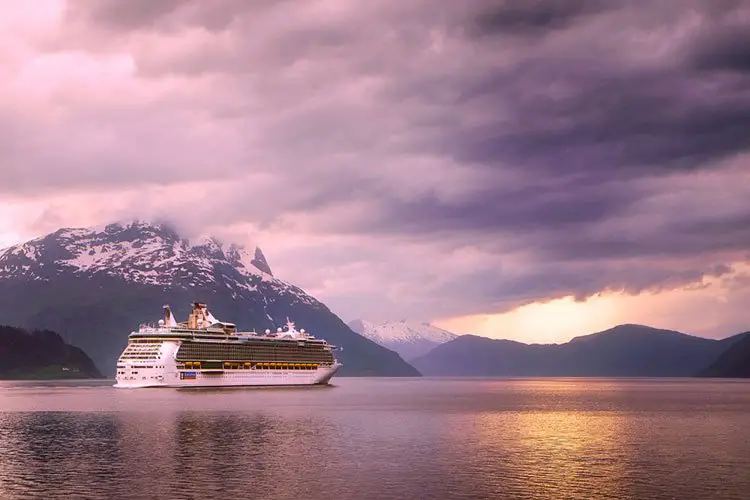
What Is A Cruise Ship?
What Is A Cruise Ship? A cruise ship is a luxurious passenger ship used for recreational and pleasure voyages and has all the amenities, entertainment options, activities, and attractions present only for the purpose of enhancing the passenger’s experience. A cruise ship usually takes a round trip of a particular route that is assigned to…
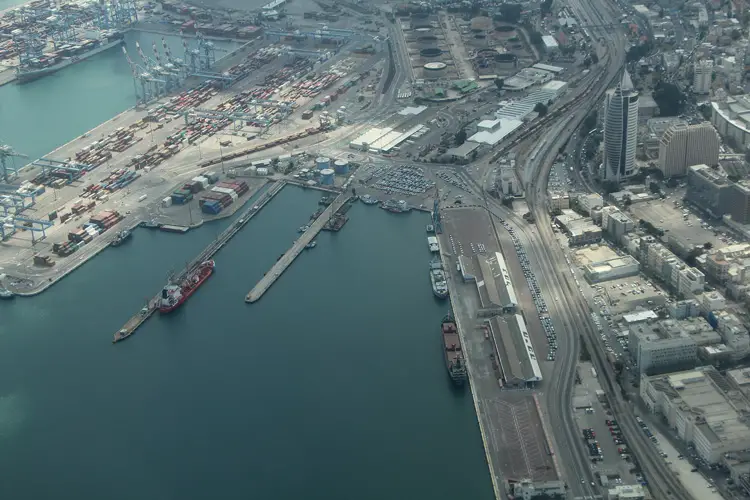
8 Major Ports in Israel
Israel or the State of Israel is a West Asian country bordered by Lebanon, Syria, Jordan, Egypt, Palestinian Territories, the Mediterranean Sea, and the Red Sea. Considered one of the most advanced countries in West Asia and the Middle East, Israel’s major economic sectors include high-technology and industrial manufacturing. Despite being a geopolitically insecure country,…

10 Unbelievable Facts About The Lost City of Atlantis
The Lost City Of Atlantis has been capturing the imagination of people and researchers for centuries. There are many myths and theories regarding this mysterious city about which there is no historical evidence. Even without any reliable information – written or otherwise, Atlantis has managed to become a part of popular culture. 10 Unbelievable Facts…
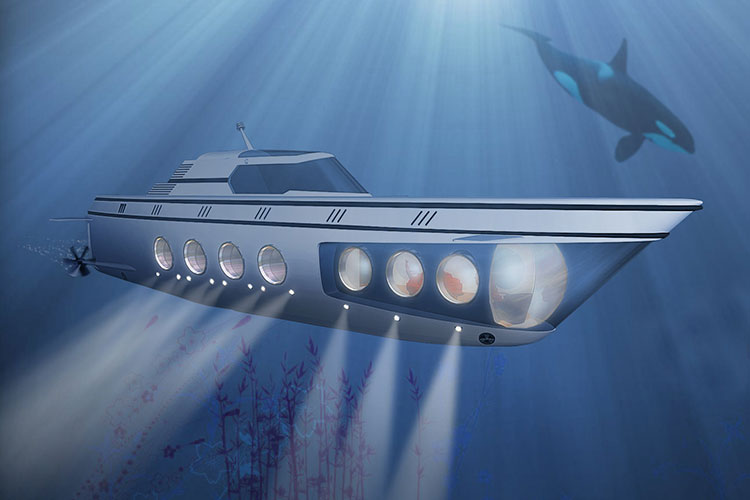
Top 15 Personal Submarines To Travel Ocean In Style
A submarine is a vessel that is capable of operating underwater independently. Most of the time it is used by the government of different countries for national protection and during wartime. Submarines are some of the rarest and the most fascinating marine vessels in the world. Unlike other ships like yachts, submarines are not very…
Leave a Reply Cancel reply
Your email address will not be published. Required fields are marked *
Save my name, email, and website in this browser for the next time I comment.
This website uses cookies to improve your experience. We'll assume you're ok with this, but you can opt-out if you wish. Read More
Sign up now for our WhatsApp newsletter and receive a FREE set of SVB playing cards!
Get the latest SVB news via WhatsApp!
- Product Selection Tool
- SVB@Youtube
- My SVB Account
- Compare list
Are you missing items that you have already placed in your shopping cart? Log in to see your saved items.
- Boat Safety Equipment
Navigation Lights on Sailing Yachts and Motor Boats

Navigation lights ensure the safety of everyone at sea. The Convention on the International Regulations for Preventing Collisions at Sea (IMO COLREG 72) precisely sets out the guidelines for navigation lights, i.e., displaying lights, their range (distance from which the light is visible), as well as how they should be constructed and assembled. Our guide is of interest to sailors and sports boats enthusiasts with boats up to 20 m in length.
Regulations and official certifications:
When must navigation lights be displayed, what are the regulations concerning the use of navigation lights at sea, how do i know that my lights are eu-compliant, what is a ce mark, how are navigation lights defined, minimum range of navigation lights:.
- From what distance must lights be visible?
- What lights are required for my boat?
What lights must be displayed on a sailboat or rowing boat with a motor?
What lights should i exhibit when at anchor, what lights should be displayed to show that a vessel is unable to manoeuvre.
- How do I indicate that my vessel has run aground?
Navigation lights – Conventional and LED:
What distinguishes led from conventional navigation lights.
- Replacement bulbs for conventional & LED lights
What are the advantages of LED navigation lights?
Switching from conventional to led navigation lights.
According to COLREGs part C, rule 20), navigation lights must always be used on board from sunset to sunrise or during the day if visibility is poor.
Please refer to the German Traffic Regulations for Navigable Maritime Waterways , §8 -10 and Preventing Collisions at Sea. Part C - Lights and Shapes. rules 20 - 31, and annexes I 1. - 14 for the exact wording.
NOTE: Vessels that are authorised to fly the German flag are generally only permitted to use approved navigation lights and sound signalling devices.
EU approval can be identified via the wheel mark symbol and the notified body number. BSH approved navigation lights (previously DHI) are marked with a model number (e.g., BSH/00/01/90).
However, even older lights with DHI approval that have already been installed maintain their approval, despite the changes made by the BSH.
In addition to the wheel mark symbol and German BSH approval, some lights are also approved by other countries, such as RINA (Registro Italiano Navale), MCA (Maritime and Coastguard Agency) and the USCG (United States Coast Guard). These are now recognised, provided the approval comes from the national approval body recognised in the country of origin.

National bodies whose accreditation is currently recognised in Germany:
| Canada: | Marine Safety Directorate |
| China: | CCS China Classification Society |
| Denmark: | Danish Maritime Authority |
| Finnland: | Finnish Maritime Administration |
| France: | Bureau Veritas S.A. |
| England: | Marine Safety Agency |
| Greece: | Ministry of Merchant Marine |
| Iceland: | Icelandic Maritime Administration |
| Italy: | Registro Italiano Navale |
| Japan | Nippon Kaiji Kyokai Material & Equipment |
| Croatia: | Croatian register of Shipping |
| Netherlands: | Directorate-General for Freight Transport, Shipping Inspectorate |
| Norway: | Sjofartsdirektoratet, Norwegian Maritime Directorate |
| Poland: | Polski Rejestr Statkow S.A. |
| Russia: | Russian Maritime Register of Shipping |
The wheel mark symbol indicates approval of the Marine Equipment Directive (MED). This approval is valid for all EU member states, both for commercial vessels and recreational shipping.
0098 = Notified Body number (here 0098 = Germanischer Lloyd in Hamburg) 18 = year in which the mark is affixed, here 2018

- A CE mark is a symbol that must be affixed to a product by the manufacturer before it is sold on the European market. It indicates that the manufacturer is aware of the specific requirements for the product in question and that it fulfils the requirements of relevant European product directives. A CE mark does not supersede approval according to collision prevention regulations.
- Navigation lights are defined in detail by the International Maritime Organization (IMO), according to the International Regulations for Preventing Collisions at Sea, 1972 (COLREGs) Convention on the International Regulations for Preventing Collisions at Sea, 1972), in sections C and D. The following rules apply:
Which navigation lights are required on board according to IMO COL REG?
Definitions according to the 1972 International Regulations for Prevention of Collisions at Sea (COL REG 72):

1. Side lights for starboard and port
A green light on the starboard side and a red light on the port side, which shine from dead ahead in an arc of 112.5° aft to a point 22.5° abaft the beam (behind the beam) on either side of the vessel. On ships of less than 20 metres in length, the two individual sidelights may be replaced by a dual-colour combined light. This must be centrally located on the bow and stern axis.

2. Stern light
A white light mounted as close to the stern as possible and shines dead ahead in an arc of 135° (67.5° to each side). The mounting height should be aligned to the height of the side lights and should never be higher.

3. Three-colour light for sailing vessels (sailing lights)
On sail boats up to a length of 20 m, the side light and stern light can be combined into one three-colour light mounted on top of the mast. However, as soon as the sail boat's motor is engaged, the use of a three-colour light is no longer permitted. The rules for motor-powered vessels then apply.

4. Mast-head light
A white light placed over the centre line of the vessel and shines dead ahead in an arc of 225° (from straight ahead up to 22.5° more aft than crosswise to each side). The mounting height should be at least 1 m higher than the side lights. In the past, the mast-head light was also referred to as a steam boat light or steamer light, as it is only seen on ships that operate under engine power.

5. Signal light or all-round light
A light that shines in a complete circle of 360°. It may emit white, red or green light, depending on use. Examples of use: All sailboats and motorboats at anchor must exhibit a white anchor light . Ships over 12m in length must, if necessary, display vessel-in-distress lights (two red signal lights) placed at a vertical distance of at least 12 m. The distance between such lights must not exceed 1 m.
From what distance must navigation lights be visible?
The range indicates the distance from which the light can be seen. The minimum ranges of navigation lights are defined according to ship size as follows::
| Ships up to 12m in overall length | Range in nautical miles (NM) |
|---|---|
| Mast-head light | 2 NM |
| Side light (starboard /port) | 1 NM |
| Stern light | 2 NM |
| Three-colour light (sail boat when at sail) | 2 NM |
| All-round light (white, red, green all-round light) | 2 NM |
| Ships of 12 - 49 m overall length | Range in nautical miles (NM) |
|---|---|
| Mast-head light | 3 NM (up to 20 m) / 5 NM (from 20m) |
| Side light (starboard /port) | 2 NM |
| Stern light | 2 NM |
| Three-colour light (sail boat when at sail) | 2 NM |
| All-round light (white, red, green all-round light) | 2 NM |
| Ships from 50 m overall length | Range in nautical miles (NM) |
|---|---|
| Mast-head light | 6 NM |
| Side light (starboard /port) | 3 NM |
| Stern light | 3 NM |
| All-round light (white, red, green all-round light) | 3 NM |
Best-seller Hella Marine

Note: When sailing boats are powered by a motor, the rules for motorboats apply and not for sailboats. The tricolour light may then no longer be displayed.

Displaying lights for sailboats up to 20 m
1 x red port side light
1 x green starboard light
1 x stern light
Also allowed:
1 x red all-round light on or near the mast top
1 x green all-round light on or near the mast top

1 x 3-colour light

Sailing vessels under 7 m (dinghies or small sports boats)
If, due to their design, no modern lights can be fitted, sailing vessels under 7 m in length and vessels being rowed must always carry an electric torch or lantern showing a white light, ready to exhibit in sufficient time to prevent a collision.
1 x Electric light or a torch with white light

Motorised vessels over 12 m
Lights used must be either / or:
1 x white masthead light fore

1 x dual colour light

Motorised vessels under 12 m
Alternatively, motorised vessels under 12 m can exhibit the following lights:
1 x white all-round light

Motorised vessels under 7 m and 7 knots maximum speed (small motor boats, dinghies or inflatables):
Motorised vehicles under 7 metres and with a maximum speed of no more than 7 knots can display the following navigation lights: all-round lights, portside and starboard lights.
The following applies in accordance with German Traffic Regulations for Navigable Maritime Waterways (SeeSchStrO): If, due to their design, no lights can be displayed (e.g., dinghies), sailing vessels under 7 m in length and 7 knots maximum speed must carry an electric hand-held spotlight or a torch to prevent collisions in the dark.
Left: 1 x white all-round light, 1 x red port side light, 1 x green starboard light
Right: 1 x hand-held spotlight or torch
Best-seller Aqua Signal Conventional

Best-seller Aqua Signal LED

Provided no engine power is used, the rules for sailboats apply. Motor-sailing vessels must display a large black cone pointing downwards when sailing during the day or at good light.
For vessels travelling under sail or at rudder during darkness or at reduced visibility, the rules for carrying lights for motorised boats automatically apply. This then depends on the length of the boat.
By day with a black cone, tip pointing downwards.
Visual signalling equipment

Torches % Spotlights

How must navigation lights be mounted on board?
Navigation lights must be securely mounted perpendicular to the waterline. Mast-head lights and stern lights should both be placed above the keel line.
At anchor during daylight? This must be displayed with a black anchor ball.
If the vessel is anchored outside of an area of water known by the River and Shipping Police Authority as an anchorage and berth for small vessels, this must be indicated as follows:
A black ball by day, 1 x white all-round light at night

Anchor Lights

If your boat is unable to manoeuvre*, this should be indicated as follows:
Stationary: 2 x red all-round light, 2 x black ball, one below the other (during the day)
Moving: 1 x red port side light, 1 x green starboard light, 1 x white stern light
* A vessel is described as if, due to exceptional circumstances (e.g., rudder failure or engine malfunction), it cannot manoeuvre as prescribed and therefore cannot avoid another vessel.

How do I indicate correctly that my sailboat or motorboat has run aground?
If your boat has run aground, this should be indicated as follows:
2 x red all-round light, 1 x white all-round light, 3 x black ball, one below the other (during the day)
Manufacturers that specialise in navigation lights such as Aqua Signal or Hella Marine supply a wide range of internationally approved navigation lights which work with conventional (with BSH bulb) or with permanently installed light-emitting semiconductor components (LEDs). The bulbs required for operation are an integral part of the approval. Replacement bulbs must also be certified so that approval / your insurance protection is guaranteed. Ships under 20 m: Stern and anchor lights require BSH-approved light bulbs with 10 watts, all other navigation lights 25 watts.
| Spare light bulb for series | Stern l / Anchor l. 12 V/10W | Stb./BB, Masth / All-rnd l. 12 V / 25W |
|---|---|---|
| Aqua Signal, Serie 40 | SVB Art. Nr. 10203 | SVB Art. Nr. 10206 |
| Aqua Signal, Serie 41 | SVB Art. Nr. 10203 | SVB Art. Nr. 10206 |
| Aqua Signal, Serie 50 | SVB Art. Nr. 10203 | SVB Art. Nr. 10206 |
| Hella Marine, Serie 2984 | SVB Art. Nr. 10203 | SVB Art. Nr. 10206 |
All series listed above with BAY15d sockets could alternatively be operated with a high-Power LED . The big advantage in doing so is that the LED is suitable for multiple voltages (10-30 V) and consumes just 3 watts during operation. Since the light colour, range of light or beam angle can vary depending on the housing, this light is NOT yet internationally approved.
Spare Bulbs - Conventional & LED

Energy consumption on sailing ships is, as ever, a topic of significant interest. This is especially true for blue-water sailors who like to sail longer distances at a stretch. The arguments for converting to LED technology are as follows:
- High energy savings due to the low power consumption
- Long lifespan (over 10,000 hours)
- MultivoltTM technology (10-30V) with greater tolerance to voltage peaks
- Compact and light housing constructions
- Waterproofed, hermetically sealed housings
- Maintenance free
When switching completely from conventional navigation lights to LED lights, lights with the BSH seal of approval / EU wheel mark meet all the requirements in terms of light colour (no risk of blue tint), range of light and beam angle, and that you are travelling in accordance with KVR.
Navigation lights with LED technology

Replacing your navigation lights is often easy to do as manufacturers usually use the same mounting points for LED lights or have an adapter plate for further use of existing drill holes:

| Existing series: | New LED series: |
|---|---|
| Aqua Signal, Series 40 with quicfit socket | Series 34 with quicfit socket |
| Aqua Signal, series 41 | Series 41 (use identical drill holes) |
| Aqua Signal, series 40 and 50 | Series 43 using adapter plate, SVB no. 14557 |
| Aqua Signal, series 40 and 50 | Series 44 using adapter plate, SVB no. 14557 |
Share our guide on social media

Written by our SVB (technical) experts
Our SVB safety experts regularly carry out maintenance checks and tests on our safety products, such as life jackets, life rafts etc. They test products and base their recommendations on many years of experience and their own know-how.
Get your card today

- Pre-paid code

- Buy a Gift Card
Boat Navigation Light Rules and Requirements

Boat navigation lights are one of the most important pieces of safety equipment on your boat, along with personal flotation devices , boat fire extinguishers and boat ventilation systems .
As a boat owner or operator, you are legally responsible for using the correct safety equipment at all times. This is your responsibility whether your boat is moving through the water or you are at anchor, day and night, in all types of weather.
Did you know that boat manufacturers, importers and dealers are not responsible for equipping your boat with legally acceptable navigation lights ? Before you take to the water, check that your navigation lights are:
- the right size and type for your boat and chosen water activity
- the right color and intensity
- attached to the correct parts of your boat
- fully operational.
It’s important to learn all you can about navigation lights for safe, legal boating! Keep reading to find out which lights to use when.
What are navigation lights for?
Navigation lights allow you to see and identify other vessels, and allow other boats to see and identify you. There is not one simple way to use navigation lights; the way they are set up on your boat will indicate the size, activity, and direction of travel of your vessel, so that you and other boat operators can make good decisions and avoid collisions.
By understanding what navigation lights mean, you will be able to safely and legally navigate shared waters under a variety of circumstances.
Boat navigation light requirements
Paddleboats, rowboats and small sailboats generally do not need to display navigation lights, but most other boats are legally required to use some or all of the following:
- A green light to indicate the starboard (starboard sidelight) attached near the bow on the starboard side
- A red light to indicate the port (port sidelight) attached near the bow on the port side
- One or more white lights (stern light and masthead light)
- Other navigation lights , such as blue flashing lights for law enforcement vessels engaged in search-and-rescue (SAR) operations, or yellow lights for vessels that are towing or being towed
Each type of navigation light also has a defined arc of illumination and range of visibility. Angles of visibility must be met when the boat is underway, which means that if your boat rides at a significant bow-up angle, you may need to adjust your navigation lights to compensate.
You must always use navigation lights between sunset and sunrise or in reduced visibility, but there are some exceptions during clear, daytime boating.
Note: It is also important to keep a flashlight on board as a temporary replacement, in case a navigation light burns out.
Boat navigation lights while underway
While your boat is underway, you are legally responsible for displaying the right type of navigation lights. Choosing the right lights depends on several factors, including:
- Whether your boat is powered by an engine (in full or in part)
- The size of your boat , measured in length
- Your boat’s speed
- Where you are boating (inland, international water, etc.)
- Whether you are at anchor.
Remember that your navigation lights must be visible and easily identifiable as such. Other lights on your boat cannot be mistaken for navigation lights, or get in the way of your navigation lights
Sailboat navigation lights
If you are operating a sailboat or nonpowered boat such as a canoe, kayak or rowboat, you still need to use the correct configuration of navigation lights for your boat size and boating circumstances. For comprehensive detailed instructions on navigation lights please refer to the USCG resource. The following are general guidelines:
Sailboats or vessels using paddles or oars, under 23 feet in length:
- One white navigation light (or lantern or flashlight) that is visible from 2 nautical miles away between sunset and sunrise or during periods of low visibility. In the presence of another vessel, the light must be displayed in time to avoid a collision.
Sailboats between 23 and 65.6 feet:
- One white stern light visible at 135 degrees and from 2 nautical miles
- One green starboard and one red port sidelight, visible across 112.5 degrees from one nautical mile away
- A tricolour light, which is a single all-around light which includes the three coloured of lights indicated above, facing the same directions, visible from a distance of 2 nautical miles. This type of light can only be used when under sail, and never when using a motor regardless of whether the sails are hoisted. It may not be used at the same time as regular sidelights.
Powered boat navigation lights
If you are operating a boat with an engine (including sailboats with motors), between sunset and sunrise or under conditions of restricted visibility, you need navigation lights.
Powered boats under 39.4 feet:
- One all-around white light, visible from all directions (360 degrees) from two nautical miles away. This light must be attached at least 39 inches above the sidelights.
Recreational powered boats between 40 feet and 164 feet:
This size of boat requires two white lights which, combined, make up 360 degrees of visibility:
- A white masthead light at the bow, visible across 225 degrees, from 2 nautical miles away. This light must be attached at least 8 feet above the gunnel.
- A white stern light at the stern, visible across 135 degrees and from 2 nautical miles away.
In addition to:
- One green starboard and one red port sidelight, visible across 112.5 degrees from one nautical mile away.
Boat navigation lights at anchor
When your boat is anchored at a dock, it is not necessary to turn on your navigation lights. However, if you are at anchor in an undesignated area, you need to make other boats aware that you are not moving by displaying an all-around white light where it will be easily visible to any other boats in the area.
Diving lights
If you are boating in a resort area or anywhere there are sunken wrecks or coral reefs, keep in mind that there could be diving activity. Keep your distance and stay alert to the possible presence of divers underwater.
Boats that are accompanying divers must display:
- Three vertical masthead lights in a red-white sequence.
Interpreting boat navigation lights
Installing and using the right navigation lights on your boat is very important, but to navigate safely, you also need to be able to interpret the navigation lights on other boats.
Remember, you may not always be boating under ideal circumstances. Make sure you learn to understand navigation lights and the United States Coast Guard rules of navigation , also called the Rules of the Road , thoroughly, so that you can make good decisions quickly, as needed.
Do you see a green light over a white light? This indicates a fishing vessel that is actively trawling. It may be necessary to avoid not only the boat, but also a large net.
Do you see a red light to the left, with two white lights to the right? Understand that you must yield to the other boat.
There are many other configurations you need to be familiar with to operate your boat safely.
Avoiding collisions
Remember, navigation lights are only a tool. You must also maintain a proper look-out at all times, by sight and hearing, to responsibly avoid collisions. Skippers must drive at an appropriate speed so that you can take effective action to avoid colliding with another vessel or body under or on the water.
Factors like visibility, traffic density, the maneuverability of your vessel, the presence of other lights from shore or scattered boat lights, the state of the sea and the draft in relation to the available depth of water must always be taken into consideration. Radar equipment may also pose certain limitations or offer certain benefits to navigating safely.
It is the boat operator’s responsibility to do everything in their power to avoid a collision, including but not limited to the correct display of navigation lights.
Learn about boat navigation and more from Drive A Boat USA!
Driving a boat safely demands a thorough knowledge of navigation, safety procedures and other technical details.
What you need to know depends in part on where you intend to go boating, the size and type of boat you will use, and what type of activity you will be engaged in, but there are many basic rules and regulations that you are legally obliged to follow no matter what the circumstances.
You can get your official state-approved online boating license today! Sign up for our fun and engaging boating safety course to get started.
- USA Boating
Latest Posts
- Diver Down Flag: What It Looks Like and When To Use It
- Parts of a Sailboat & Sailing Terminology
- All About Safe Boating with Infants and Children
- Boat Right of Way Rules and Power-Driven Vessel Path Crossing
- What is Needed for Steering Control on a PWC?
- August 2024
- February 2024
- December 2023
- October 2023
- September 2023
- January 2023
- November 2022
- Get certified now
- Replacement California Boater Card
Lights and shapes

Definitions
- Masthead light means a white light placed over the fore and aft centreline of the vessel showing an unbroken light over an arc of the horizon of 225° and so fixed as to show the light from right ahead to 22.5° abaft the beam on either side of the vessel.
- Sidelight means a green light on the starboard side and a red light on the port side each showing an unbroken light over an arc of the horizon of 112.5° and so fixed as to show the light from right ahead to 22.5° abaft the beam on its respective side. In a vessel of less than 20 metres in length the sidelights may be combined in one lantern carried on the fore and aft centreline of the vessel.
- Sternlight means a white light placed as nearly as practicable at the stern showing an unbroken light over an arc of the horizon of 135° and so fixed as to show the light 67.5° from right aft on each side of the vessel.
- Towing light means a yellow light having the same characteristics as the sternlight.
- All-round light means a light showing an unbroken light over an arc of the horizon of 360°.
- Flashing light means a light flashing at regular intervals at a frequency of 120 flashes or more per minute.
Colour legend
Power-driven vessel underway
A power-driven vessel underway shall exhibit:
- a masthead light forward;
- a second masthead light abaft of and higher than the forward one; except that a vessel of less than 50 metres in length shall not be obliged to exhibit such light but may do so;
- sidelights;
- a sternlight.
|
| ||
|
|
|
|
| Abeam, port side | Ahead | Astern |
|
| ||
|
|
|
|
| Abeam, port side | Ahead | Astern |
Sailing vessels underway and vessels under oars
A sailing vessel underway shall exhibit:
In a sailing vessel of less than 20 metres in length the lights may be combined in one lantern carried at or near the top of the mast where it can best be seen.
A sailing vessel underway may, in addition to the lights, exhibit at or near the top of the mast, where they can best be seen, two all-round lights in a vertical line, the upper being red and the lower green, but these lights shall not be exhibited in conjunction with the combined lantern.
4 lights configurations sailing
|
| ||
|
|
|
|
| Abeam, port side | Ahead | Astern |
|
| ||
|
|
|
|
| Abeam, port side | Ahead | Astern |
|
| ||
|
|
|
|
| Abeam, port side | Ahead | Astern |
|
| ||
|
|
|
|
| Abeam, port side | Ahead | Astern |
A sailing vessel of less than 7 metres in length shall, if practicable, exhibit the lights prescribed above, but if she does not, she shall have ready at hand an electric torch or lighted lantern showing a white light which shall be exhibited in sufficient time to prevent collision.
A vessel under oars may exhibit the lights prescribed in this Rule for sailing vessels, but if she does not, she shall have ready at hand an electric torch or lighted lantern showing a white light which shall be exhibited in sufficient time to prevent collision.
Sailing and Motoring
A vessel proceeding under sail which has her engine running shall exhibit, forward where it can best be seen, a conical shape, apex downwards. She shall exibit lights according to a power-driven vessel.
|
| Day sign | |
|
|
|
|
| Abeam, port side | Ahead | Astern |
A vessel at anchor shall according to Rule 30 (a) (b) exhibit where it can best be seen:
- in the fore part, an all-round white light or one ball;
- at or near the stern and at a lower level than the light prescribed in Rule 30(a)(i), an all-round white light.
|
| Day sign (1 black sphere) | |
|
|
|
|
| Abeam, port side | Ahead | Astern |
|
| Day sign (1 black sphere) | |
|
|
|
|
| Abeam, port side | Ahead | Astern |
|
| Day sign (1 black sphere) | |
|
|
|
|
| Abeam, port side | Ahead | Astern |
A vessel aground shall according to Rule 30 (d) exhibit the lights prescribed in Rule 30(a) or (b) and in addition, if practicable, where they can best be seen;
- two all-round red lights in a vertical line;
- three balls in a vertical line.
|
| Day sign ( black spheres) | |
|
|
|
|
| Abeam, port side | Ahead | Astern |
A power-driven vessel when towing shall exhibit:
- two masthead lights in a vertical line. When the length of the tow, measuring from the stern of the towing vessel to the after end of the tow exceeds 200 metres, three such lights in a vertical line; Rule 24 ;
- a sternlight;
- a towing light in a vertical line above the sternlight;
- when the length of the tow exceeds 200 metres, a diamond shape where it can best be seen.
| ||
| Abeam, port side | ||
|
|
|
| Ahead, Day sign (diamond shapes) | Ahead | Astern |
| ||
| Abeam, port side | ||
|
|
|
| Ahead, Day sign (diamond shapes) | Ahead | Astern |
| Abeam, port side | |
|
|
|
| Ahead, Day sign (no shapes) | Ahead | Astern |
| Abeam, port side | |
|
|
|
| Ahead, Day sign (no shapes) | Ahead | Astern |
Towing an inconspicuous, partly submerged object
An inconspicuous, partly submerged vessel or object, or combination of such vessels or objects being towed; Rule 24 (g) , shall exhibit:
- if it is less than 25 metres in breadth, one all-round white light at or near the forward end and one at or near the after end except that dracones need not exhibit a light at or near the forward end;
- if it is 25 metres or more in breadth, two additional all-round white lights at or near the extremities of its breadth;
- if it exceeds 100 metres in length, additional all-round white lights between these lights so that the distance between the lights shall not exceed 100 metres;
- a diamond shape at or near the aftermost extremity of the last vessel or object being towed and if the length of the tow exceeds 200 metres an additional diamond shape where it can best be seen and located as far forward as is practicable.
| ||
| Abeam, port side | ||
| ||
| Abeam, port side | ||
| ||
| Abeam, port side | ||
| ||
| Abeam, port side (note that often a fifth round white light in the center is added) | ||
|
| |
| Ahead | Astern | |
| ||
| Day sign, Abeam, port side | ||
Pushing from ahead or towing alongside
When a pushing vessel and a vessel being pushed ahead are rigidly connected in a composite unit they shall be regarded as a power-driven vessel and exhibit the normal lights.
A power-driven vessel when pushing ahead or towing alongside, except in the case of a composite unit; Rule 24 (c) , shall exhibit:
- two masthead lights in a vertical line;
A vessel or object being towed shall exhibit:
- Provided that any number of vessels being towed alongside or pushed in a group shall be lighted as one vessel,
- a vessel being pushed ahead, not being part of a composite unit, shall exhibit at the forward end, sidelights;
- a vessel being towed alongside shall exhibit a sternlight and at the forward end, sidelights.
| |
| Abeam, port side | |
|
|
| Ahead | Astern |
| Abeam, port side |
|
|
| Ahead | Astern |
Fishing – Trawling
A vessel engaged in fishing, whether underway or at anchor, shall exhibit only the lights and shapes prescribed below; Rule 26
A vessel when engaged in trawling, by which is meant the dragging through the water of a dredge net or other apparatus used as a fishing appliance, shall exhibit:
- two all-round lights in a vertical line, the upper being green and the lower white, or a shape consisting of two cones with their apexes together in a vertical line one above the other;
- a masthead light abaft of and higher than the all-round green light; a vessel of less than 50 metres in length shall not be obliged to exhibit such a light but may do so;
- when making way through the water, in addition to the lights prescribed hereh, sidelights and a sternlight.
- when shooting nets, white light over white light (Flag Z by day);
- when hauling nets, white light over red light (Flag G by day);
- When nets are caught on the bottom, red light over red light (Flag P by day).
| Day sign | |
|
|
|
| Abeam, port side | Ahead | Astern |
| Day sign • | |
|
|
|
| Abeam, port side | Ahead | Astern |
| Day sign • | |
|
|
|
| Abeam, port side | Ahead | Astern |
| Day sign • | |
|
|
|
| Abeam, port side | Ahead | Astern |
Trawling in span
When pair trawling, each vessel shows searchlights on water aiming forward ( Flag T by day); Rule 26 (f) (b)ǂ(2)
|
|
| Ahead | Astern |
Fishing, other than trawling
A vessel engaged in fishing, other than trawling , according to Rule 26 (c) shall exhibit:
- two all-round lights in a vertical line, the upper being red and the lower white, or a shape consisting of two cones with apexes together in a vertical line one above the other;
- when there is outlying gear extending more than 150 metres horizontally from the vessel, an all-round white light or a cone apex upwards in the direction of the gear;
- when making way through the water, in addition to the lights prescribed here, sidelights and a sternlight.
| Day sign | |
|
|
|
| Abeam, port side | Ahead | Astern |
Purse seining
Purse Seiners will exhibit two all-round yellow lights in a vertical line, flashing alternately; Rule 26 (f) 3ǂ(iii)
|
|
|
| Abeam, port side | Ahead | Astern |
Constrained by draught
A vessel constrained by her draught / draft may, (and not “shall”!) in addition to the lights prescribed for power-driven vessels, exhibit where they can best be seen three all-round red lights in a vertical line, or as day sign a cylinder, Rule 28
| Day sign (black vertical cylinder) | |
|
|
|
| Abeam, port side | Ahead | Astern |
Not under command
A vessel not under command, sometimes knows as a NUC N ot U nder C ommand." aria-label="Illumination" data-bs-original-title="NUC"> vessel, shall according to Rule 27(a) exhibit:
- two all-round red lights in a vertical line where they can best be seen;
- two spherical shapes in a vertical line where they can best be seen; and
- when making way through the water also normal sidelights and a sternlight (not shown in the examples below).
| Day sign (two black spheres) | |
|
|
|
| Abeam, port side | Ahead | Astern |
|
|
|
| Abeam, port side | Ahead | Astern |
Restricted in her ability to manoeuvre
A vessel restricted in her ability to manoeuvre, sometimes knows as a RAM R estricted in her A bility to M anoeuvre." aria-label="Illumination" data-bs-original-title="RAM"> vessel, except a vessel engaged in mine clearance operations , shall according to Rule 27(b) exhibit:
- three all-round lights in a vertical line where they can best be seen. The highest and lowest of these lights shall be red and the middle light shall be white;
- three shapes in a vertical line where they can best be seen. The highest and lowest of these shapes shall be balls and the middle one a diamond;
- when making way through the water, also a masthead light or lights, sidelights and a sternlight
| Day sign: two black spheres and in the middle a black diamond shape | |
|
|
|
| Abeam, port side | Ahead | Astern |
|
|
|
| Abeam, port side | Ahead | Astern |
Dredging or underwater operations
A vessel engaged in dredging or underwater operations, when restricted in her ability to manoeuvre; Rule 27(d) , shall exibit
- two all-round red lights or two balls in a vertical line to indicate the side on which the obstruction exists;
- two all-round green lights or two diamonds in a vertical line to indicate the side on which another vessel may pass; and
- when at anchor (or not making way), the lights or shapes prescribed in this section instead of the lights or shapes prescribed in Rule 30
|
|
|
| Ahead, day signs | Ahead | Astern |
|
|
|
| Ahead, day signs | Ahead | Astern |
|
|
|
| Ahead, day signs | Ahead | Astern |
Small diving vessel
or
| Day signs | |
|
|
|
| Abeam, port side | Ahead | Astern |
A vessel engaged on pilotage, according to Rule 29 , duty shall exhibit:
- at or near the masthead, two all-round lights in a vertical line, the upper being white and the lower red;
- when underway, in addition, sidelights and a sternlight; as shown in the example below.
|
|
|
| Abeam, side | Ahead | Astern |
Hovercraft, hydrofoil ferry
An air-cushion vessel when operating in non-displacement mode shall, besides a masthead light forward, (plus a masthead light abaft if longer than 50 m) sidelights and a sternlight, exhibit an all‑round flashing yellow light (faster than 2 flashes per second). Rule 23(b)
Also a hydrofoil ferry or high speed catamaran when acting as ferry is often allowed under local regulations to exhibit an all-round flashing yellow light.
|
|
|
| Abeam, port side | Ahead | Astern |
Minesweeper
A vessel engaged in mine clearance operations shall in addition to the lights prescribed for a power-driven vessel, or to the lights or shape prescribed for a vessel at anchor, exhibit three all-round green lights or three balls. One of these lights or shapes shall be exhibited near the mast head and one at each end of the fore yard. These lights or shapes indicate that it is dangerous for another vessel to approach within 1000 metres of the mine clearance vessel. Rule 27(f)
|
|
|
| Ahead, day signs (3 black spheres) | Ahead | Astern |
See all chapters
Course overview Chapter 1 – Positions Chapter 2 – Nautical chart Chapter 3 – Compass Chapter 4 – Plotting and piloting Chapter 5 – Plotting and piloting – Advanced Chapter 6 – Tides Chapter 7 – Tide prediction Chapter 8 – Currents Chapter 9 – Navigation aids Chapter 10 – Lights and Shapes

Service Locator
- Angler Endorsement
- Boat Towing Coverage
- Mechanical Breakdown
- Insurance Requirements in Mexico
- Agreed Hull Value
- Actual Cash Value
- Liability Only
- Insurance Payment Options
- Claims Information
- Towing Service Agreement
- Membership Plans
- Boat Show Tickets
- BoatUS Boats For Sale
- Membership Payment Options
- Consumer Affairs
- Boat Documentation Requirements
- Installation Instructions
- Shipping & Handling Information
- Contact Boat Lettering
- End User Agreement
- Frequently Asked Questions
- Vessel Documentation
- BoatUS Foundation
- Government Affairs
- Powercruisers
- Buying & Selling Advice
- Maintenance
- Tow Vehicles
- Make & Create
- Makeovers & Refitting
- Accessories
- Electronics
- Skills, Tips, Tools
- Spring Preparation
- Winterization
- Boaters’ Rights
- Environment & Clean Water
- Boat Safety
- Navigational Hazards
- Personal Safety
- Batteries & Onboard Power
- Motors, Engines, Propulsion
- Books & Movies
- Cockpit Confessions
- Communication & Etiquette
- Contests & Sweepstakes
- Colleges & Tech Schools
- Food, Drink, Entertainment
- New To Boating
- Travel & Destinations
- Watersports
- Anchors & Anchoring
- Boat Handling
Anchor Light Requirements
USCG anchor light requirements for inland waterways.
Advertisement
The Inland Rules have specific requirements as to anchor lights. That rule is quoted below, as is the USCG site reference.
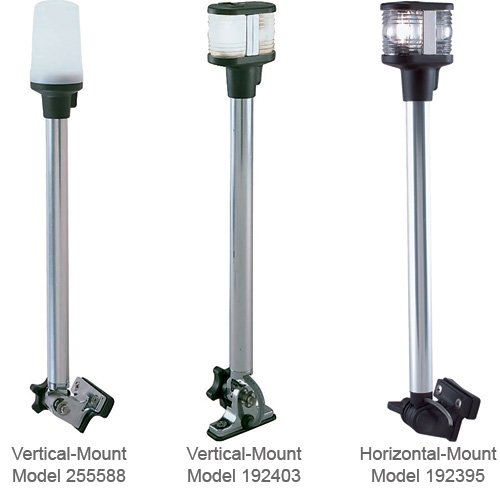
A 360-degree white all-around masthead light with two-mile visibility normally fulfills this requirement for most pleasure boats, but familiarize yourself with and follow the rule. Wire gauge, length of wiring, connections and battery condition can affect a light's performance. Follow manufacturer's instructions to ensure compliance with U.S. Coast Guard regulations. If you have one of the newer LED anchor lights, it may not be as bright as earlier lights. Be sure that the manufacturer specifies in writing that it meets USCG requirement.
Displaying a proper anchor light when anchored at night isn't merely a matter of law. It's a matter of safety for you and others. Even if the boat is in a known or designated anchorage area, dinghies and other boats may be traveling in that area and will need to know the location of your boat. People have been severely injured and killed because a skipper decided that he'd not burn an anchor light.
Following is Rule 30 of the Rules found here .
Rule 30 - Anchored Vessels and Vessels Aground
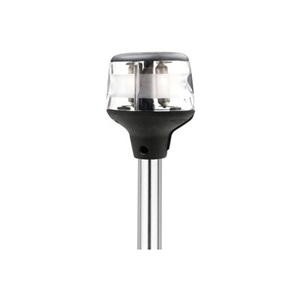
(a) A vessel at anchor shall exhibit where it can best be seen:
(i) in the fore part, an all-round white light or one ball;
(ii) at or near the stern and at a lower level than the light prescribed in subparagraph (i), an all-round white light.
(b) A vessel of less than 50 meters in length may exhibit an all-round white light where it can best be seen instead of the lights prescribed in paragraph (a) of this Rule.
(c) A vessel at anchor may , and a vessel of 100 meters and more in length shall, also use the available working or equivalent lights to illuminate her decks.
(d) A vessel aground shall exhibit the lights prescribed in paragraph (a) or (b) of this Rule and in addition, if practicable, [Inld] where they can best be seen;
(i) two all-round red lights in a vertical line;
(ii) three balls in a vertical line.
(e) A vessel of less than 7 meters in length, when at anchor not in or near a narrow channel, fairway or where other vessels normally navigate, shall not be required to exhibit the shape prescribed in paragraphs (a) and (b) of this Rule.
(f) A vessel of less than 12 meters in length, when aground, shall not be required to exhibit the lights or shapes prescribed in subparagraphs (d)(i) and (ii) of this Rule.
(g) A vessel of less than 20 meters in length, when at anchor in a special anchorage area designated by the Secretary, shall not be required to exhibit the anchor lights and shapes required by this Rule. [Inld]
Related Articles
The truth about ceramic coatings for boats.
Our editor investigates the marketing claims of consumer-grade ceramic coatings.
Fine-Tune Your Side Scan Fishfinder
Take your side-scanning fishfinder off auto mode, and you’ll be spotting your prey from afar in no time
DIY Boat Foam Decking
Closed-cell foam flooring helps make boating more comfortable. Here’s how to install it on your vessel
Click to explore related articles
BoatUS Editors
Contributor, BoatUS Magazine
Award-winning BoatUS Magazine is the official publication of Boat Owners Association of The United States. The magazine provides boating skills, DIY maintenance, safety, news and more from top experts.
BoatUS Magazine Is A Benefit Of BoatUS Membership
Membership Benefits Include:
Subscription to the print version of BoatUS Magazine
4% back on purchases from West Marine stores or online at WestMarine.com
Discounts on fuel, transient slips, repairs and more at over 1,200 businesses
Deals on cruises, charters, car rentals, hotel stays and more…
All for only $25/year!
We use cookies to enhance your visit to our website and to improve your experience. By continuing to use our website, you’re agreeing to our cookie policy.

Boat Navigation Light Rules Explained (For Beginners)
Boat navigation light rules can be a little difficult for newcomers to understand. This is probably because these light rules can change depending on a wide variety of factors.
Failing to comply with these rules can leave you open to enforcement violations as well as lawsuits.
Also, knowing these rules will help keep you and other boaters safe while out on the water, so you must learn and remember them.
Here’s everything you should know about the boat navigation light rules.
Table of Contents

Why Have Boat Navigation Light Rules At All
Boat navigation light rules help boaters communicate with each other. They also help to determine who has the right of way. This is important as it determines what actions boats will take as they pass one another.
Without these guidelines, there would be many more accidents out on the water as people wouldn’t know how to interact.
Remember, when you’re out on the open water, there aren’t any designated lanes to follow, and without rules, boaters can easily become confused about which way they should turn or whether or not they should even turn at all.
On top of this, these rules help establish methods for boaters to tell each other when they’re anchored or when they’re in distress. Use your lights correctly when you need help, and you’re much more likely to get it.
When do I Need to Follow Boat Navigation Light Rules?
Light rules apply any time between sunset and sunrise. They also apply any time visibility is low.
An example of this could be during foggy or rainy weather.
A more unusual example of this could be during a solar eclipse. Basically, if you feel that having the lights on will help others see you better, it’s a good idea to turn them on.
The Different Light Rules by Boat and Size
Different types of boats will have different light rules that they need to follow. These sets of rules are broken down based on whether the boat is a sailboat or a powered boat.
Once this is established, the rules are then broken down by size.
The different sizes to consider are boats shorter than 39.4 feet, boats sized between 39.4 and 65.6 feet, and boats greater than 65.6 feet.
If you’re wondering why the numbers are so precise, it’s because this is the conversion from meters. 39.4 feet equals 12 meters, and 65.6 feet equals 20 meters.
Generally, all boats will have a red light on their port side and a green light on their starboard side. To put it in plain English, if you’re in the driver’s seat, the red light goes on the left, and the green light goes on the right.
A white light should be at the stern of the boat. The stern is the rear of the boat.
Powered Boat Light Placement

Here are the lights you’ll need when operating a powered boat, depending on the size of the boat you’re operating.
- Boats less than 12 meters or 39.4 feet long:
You’ll need one red light and one green light at the front port and starboard sides of the boat for these boats. These lights should be positioned so that they can be seen at an angle of 112.5 degrees. The sidelights should be strong enough to be seen from a mile away.
You’ll also need to mount them towards the bow of the boat. This is otherwise known as the front of the boat.
Additionally, you’ll need one white light that can be seen from all angles. It should be strong enough to be seen from two miles away.
This light will need to be mounted at least 39 inches or 99 centimeters higher than the red and green lights.
- Boats greater than 12 meters or 39.4 feet but less than 20 meters or 65.6 feet:
With boats of this size, you’ll still need your red and green lights, but your white lights will change.
In this case, you’ll mount a red light to your port or left side and a green light to your starboard or right side. These lights will need to be seen from an angle of 112.5 degrees, and they’ll need to be seen from a distance of one mile.
The two white lights will need to be mounted at the stern and masthead of the boat. Stern lights can also be referred to as the aft light. Either way, it just means the light at the back of the boat.
This light will need to be seen from a 225-degree angle facing the rear. It needs to be strong enough to be seen from 2 miles away.
The masthead light is at the forward position of the boat. This light is mounted on the masthead, and it must cover a 135-degree angle.
The light will need to be visible from 2 miles away.
Masthead lights must be mounted at least 8 feet above the gunnel. The gunnel is the top edge of the side of the boat.
- Boats larger than 20 meters or 65.6 feet long:
To operate a non-commercial boat over 20 meters or 65.6 meters long, you’ll have to have the same lights in the same positions as the smaller boats. However, you’ll also need to add matt black inboard screens to your sidelights.
Sail Boats and Other Unpowered Boats

These boats can be broken down into two different size categories.
These two categories are under 23 feet or 7 meters and boats that are over 23 feet or 7 meters.
Unpowered boats such as sailboats, rowboats, and kayaks under 23 feet in length only need to have a white light on them. This white light can be anything from a flashlight to a lantern.
However, you can still opt to place red and green lights at their appropriate places.
Larger sailboats will need to have a 135 degree white light at the stern and 112.5 degree red and green lights at the port and starboard sides. The white light should be visible from 2 miles away, while the red and green lights should be visible from 1 mile away.
Alternatively, a tri-color light could be placed on the masthead.
This light will have all three lights built into it, and it should be visible from at least 2 miles away.
Advice For All Boats Regarding Light
Regardless of what boat size you’re on, it is a good idea to have a flashlight with you.
If your boat lights become inoperable, you’ll at least have one light that you can signal with.
Should you find yourself on the water at night in a disabled boat , your flashlight may be the only thing keeping you from being crashed into.
Light Rules For Boats at Anchor
When you’re anchored at a marina or dock, you won’t have to worry about specific boat light rules and regulations.
However, when you’re anchored out on the water, you must follow boat light rules as this will help keep other boaters from running into you.
It will also help establish that you have the right of way so you won’t have to move every time a larger boat comes your way.
Of course, having the right lights doesn’t mean you’ll be able to anchor just anywhere. You’ll still have to follow any inland rules when it comes to anchoring your boat.
When anchored, you’ll need to display an all-around white light that lets other boaters know your position. This light should be placed where other boaters can best see it. For example, a sailboat might put this light at the top of its mast. Also, another all-around white light might be placed near the deck to help identify your anchored boat to nearby boats.
Boats Under Distress
Boats under distress should display what is known as a visual distress signal so that they can get help. At night, these distress signals will come in flares, parachute flares, and lights.
You should have at least three devices on your boat to use for signaling.
This could come in a variety of forms, and you can use the same one three times. For example, your three devices could be having three signaling flares with you.
Only use these lights when you’re in danger. Failure to do so can result in heavy fines and potential imprisonment.
Determining Who Has The Right of Way
When you come across another boat, and you can only see a white light, then you’ll know that you’re either approaching an anchored vessel or a vessel that is moving in front of you. In this case, you can overtake them and go around them from either side.
If you come across a green light and a white light, then you have the right of way. In boating terms, this means that you are the stand-on vessel.
Technically speaking, the other boat should give way, and you won’t have to worry about changing your course.
However, there is always a chance that the other person will not give way for some reason, and you should be ready to move. You never know, the other boater may not see you, or they may not know the rules as they should. Remember, being right won’t mean anything if you end up dead in a boat crash.
If you come across a red and white light, you are the one that needs to give way. In this case, you’ll want to slow your boat down and pass by them, probably behind their path.
In all of these scenarios I described, you were in a powered vessel, and you were passing a powered boat or a sailboat that was driving while under power.
However, what happens when you encounter a sailboat or other unpowered vessel in a powered vessel?
In this case, you’ll see a red light, a green light, or a white light, but you won’t see all three. Regardless of what you see, you’ll want to give way. This is because these boats can’t maneuver as well as you, and they probably won’t be able to get out of your way before you come across them.
At this point, you can see why different boats need different types of lights and why it’s important to use the lights that apply to your particular craft. Use the wrong lights, and you’ll confuse the other boaters around you. This could easily lead to an accident that could have easily been avoided.
What About Boaters Who Are Color Blind?
Unfortunately, people who are color blind won’t safely operate a boat at night by themselves.
Also, they won’t be able to get a captain’s license as you need to pass a color blind test to get this license. Here’s an article we wrote about all you need to know about boat license types (with prices) .
If you’d like to do some recreational boating at night, but you can’t differentiate between the colors red and green, you might want to consider bringing a friend along.
This way, your friend can tell you what colors you’re coming up on so that you can safely navigate yourself past other boats.
4 Types of Boat Lights
- The red and green lights that go on the sides of a boat are known as sidelights.
- White lights that only face backward are known as stern lights, and white lights that face forward are known as masthead lights.
- An all-round white light is a white light that faces 360 degrees. These lights are used on smaller boats and on boats that are at anchor. They can be replaced by making use of a stern light and a masthead light.
- Another type of light is the tri-color light. A tri-color light can be used on a sailboat to portray the white, green, and red lights. Bi-color lights are also available for small powered boats and sailboats. These lights display both red and green light.
The combination of lights that are displayed will always give the boater a 360-degree field of light.
This ensures that other boaters can see them no matter where they are in relation to each other.
Safety Precautions To Be Aware Of
Even new boats can have lights that weren’t configured correctly or lights that don’t work.
It’s important that you check these lights before you head out on the water.
This is true even if you don’t intend on staying out after dark. After all, it’s always possible that you could become stranded until after dark or that it could become too foggy to operate out on the water without lights.
Other Things You Should Know About Boating At Night
Boat navigational light rules are critical for nighttime boating, but there are other things to consider as well.
One thing to consider when boating at night is the use of a lookout.
Having one of your passengers act as a lookout will make it more likely that you’ll spot problems in advance.
Remember, other boaters aren’t the only potential hazards you can run into at night. Shallow shipwrecks, low water depths, and unlit piers, docks, and jetties can also become hazards if they aren’t noticed in time for you to avoid them.
High beams should be used for docking purposes only. This is because using them while on the water can confuse other boaters.
Also, the high beams can shine into other sailor’s eyes and can give them night blindness.
Just think about it this way.
It isn’t safe to drive towards another car with your high beams on, so why would it be safe to drive towards another boat with high beams on?
Driving Speed
Nighttime boating should be done at slower speeds than day time boating. The primary reason for this is that visibility is more limited at night.
Driving slower will help to give you more time to react to boaters and other hazards.
When you first start boating, you’ll still have to take a moment to think about the lights you see. Driving at a slower speed will give you this additional time without affecting your safety.
Not All Lights On The Water Are Boats!
I’ll end this post with a funny story I once heard about a boat traveling at night. This story has changed many times over the years, but the gist of it’s still the same.
It goes like this:
A large vessel was traveling at night when they came across a white light in front of them. The ship captain immediately got on the radio and contacted the other vessel to demand that they get out of the way.
The other vessel responded by telling the captain to change his course. To this, the captain responded with, “This is the warship, the USS Enterprise, and I demand you change course, or we’ll be forced to take action!”.
To this, the other vessel responded with, “This is a lighthouse, and you are on course to become shipwrecked.”.
This isn’t a real story, and now that you know proper boat navigation light rules, it is a story that could never happen to you.
If you came across a white light and thought it was a boat, you’d assume it was unpowered or at anchor, and you’d take steps to go around it.
Click to share...
- Members Forum
- Log In / Create Account
Navigation Lights at Night
by Harbor Sailboats | Dec 4, 2020 | Blog | 1 comment

Great article! Boat lights are the means of communication between sailing vessels. These lights are also a tool to let my presence known even from a distance.
Submit a Comment Cancel reply
You must be logged in to post a comment.
Latest Blog Posts
- Talk and Walk
- Sailing Lessons in San Diego
- Water in the Bilge
- Bow Standing
- Gear then Steer
- 2024 BOAT BUYERS GUIDE
- Email Newsletters
- Boat of the Year
- 2024 Freshwater Boat and Gear Buyers Guide
- 2024 Boat Buyers Guide
- 2024 Water Sports Boat Buyers Guide
- 2024 Pontoon Boat Buyers Guide
- Cruising Boats
- Pontoon Boats
- Fishing Boats
- Personal Watercraft
- Water Sports
- Boat Walkthroughs
- What To Look For
- Watersports Favorites Spring 2022
- Boating Lab
- Boating Safety
- Ultimate Boat Giveaway

Guide to LED Pontoon Boat Lights
- By Elliott Stark
- August 20, 2024
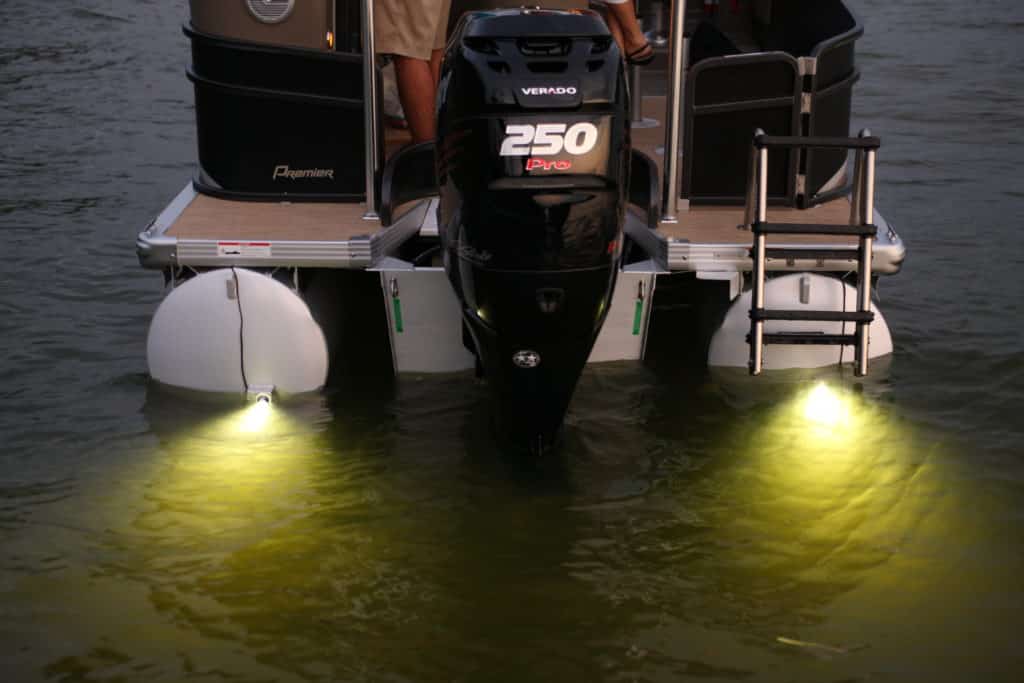
Whether on the lake, river or bay, nothing packs a party quite like a pontoon boat. Recent advancements in LED lighting take the pontoon boat party to a whole new level. What follows is our take on dialing in your pontoon boat led lighting setup.
What Lights Does a Pontoon Boat Need?
Like all vessels, the right pontoon boat LED lighting setup involves a combination of lights that you’re required to have and those that make the experience more fun. Whether navigation lights, spreader bars, underwater lighting or light strips around the deck, LED lights are functional, versatile and quite a bit of fun.
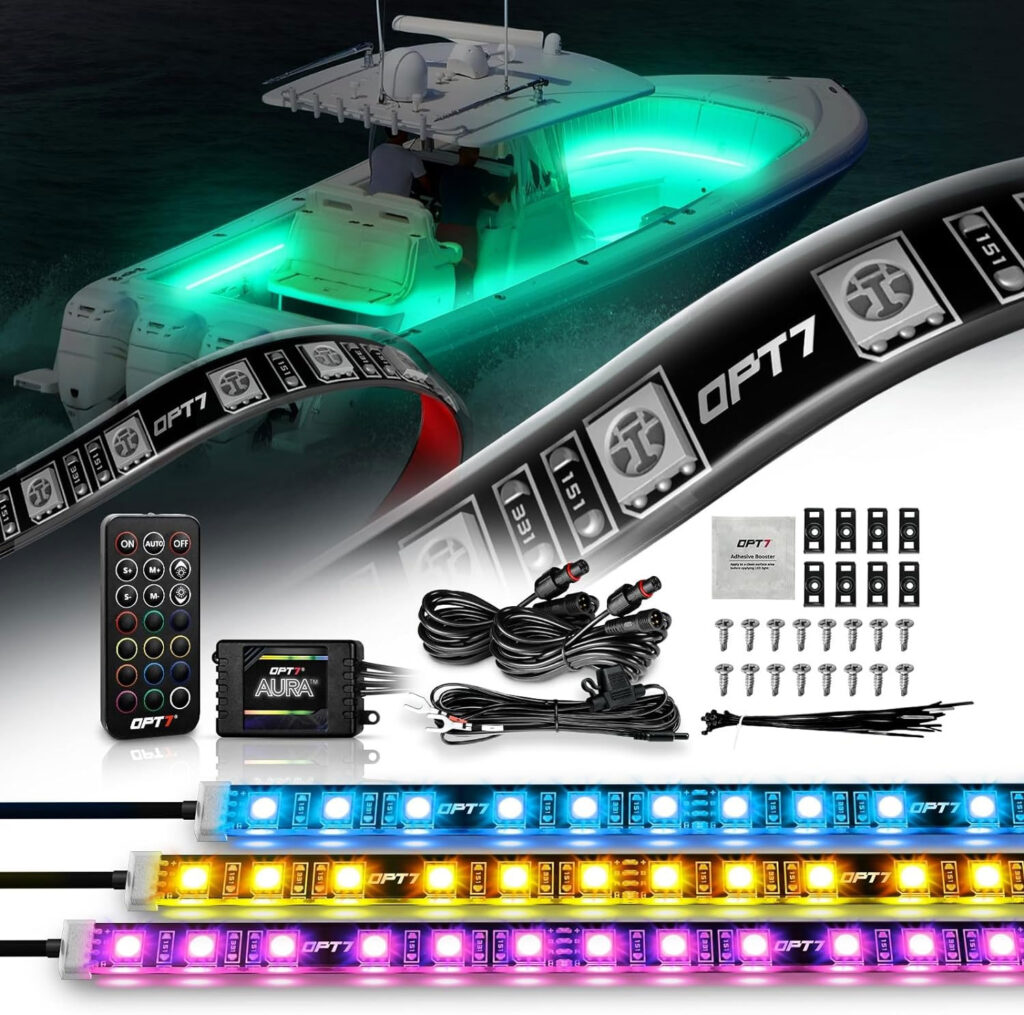
LED setups offer a number of customization possibilities. For instance, they may be:
- Dimmable: You can control and adjust the brightness and lumen output via apps on your marine electronics or smartphone.
- Multi-color changing: The same bulb can produce an incredible variety of colors. Previous lighting options, if they had the ability to change color at all, were extremely limited.
- Syncable with sound: With the right setup and installation, you can make the lights on your pontoon boat change in brightness and color to music. LED light strips like these are really cool for kids and adults alike.
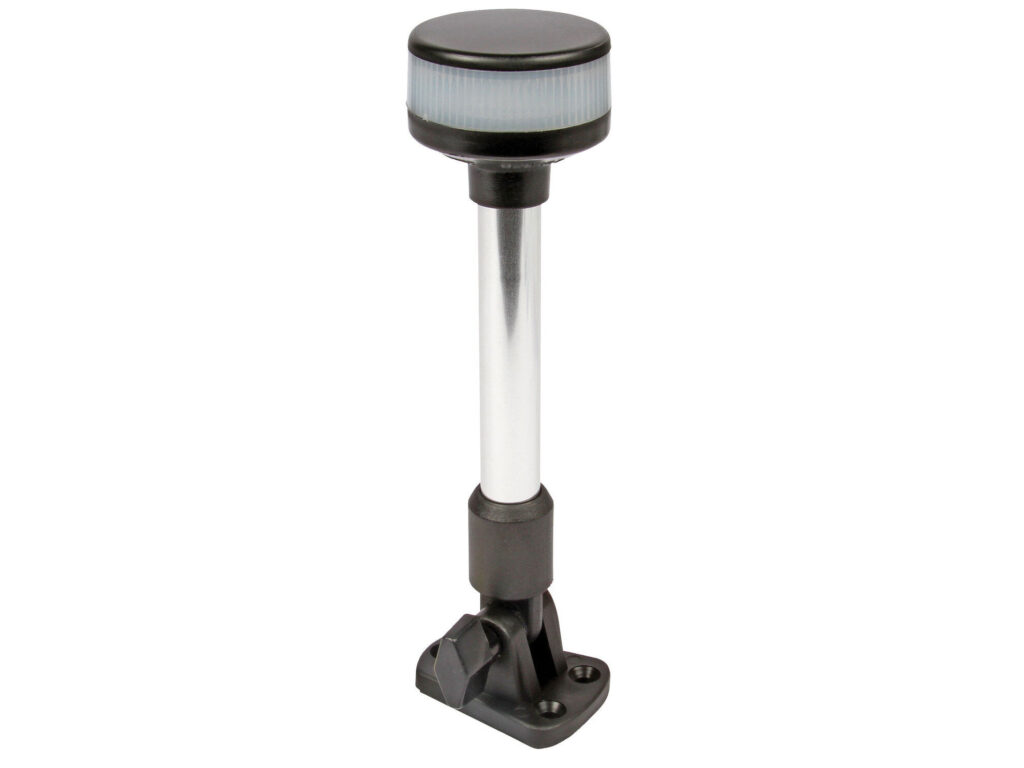
Lighting for Pontoon Boats: Legal Requirements
The exact lighting setup you will need depends on the length of your pontoon boat. Be sure to check the legal requirements for your situation. The requirements include the number of lights, angle of light emitted, and visible range of the light.
At its most basic, your pontoon boat needs the following:
- Masthead lights: These are typically white lights that are mounted in a place that is visible to other boats. This base-mounted, fold down LED pole light is a great example.
- Navigation lights: These are the classic red and green lights mounted on the bow of your boat. In addition to being required by law, they let other vessels know which direction you are traveling at night.
- Stern lights : You also need stern lights mounted on the back of your boat and an all-around light.
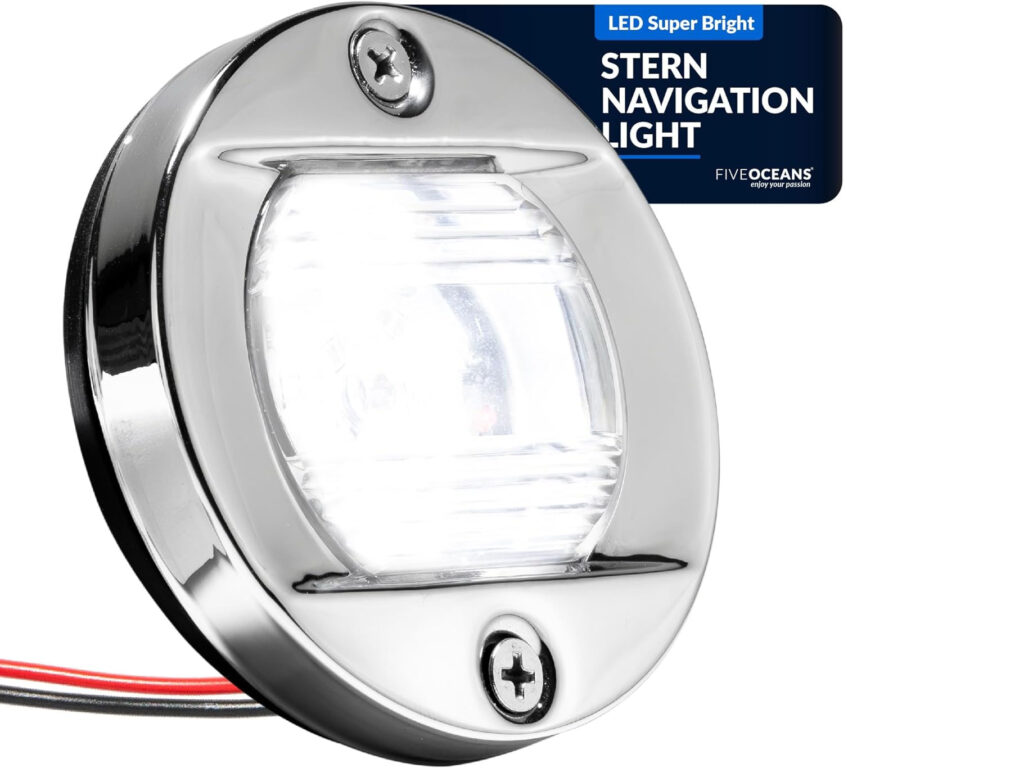
‘Nice-to-Have’ Lights for a Pontoon Boat
Beyond the lights required by law, you can outfit your pontoon with an incredible variety of exciting LED lighting options. Consider illuminating the dock, installing courtesy lights along pathways and steps, and adding submersible underwater LED lights .
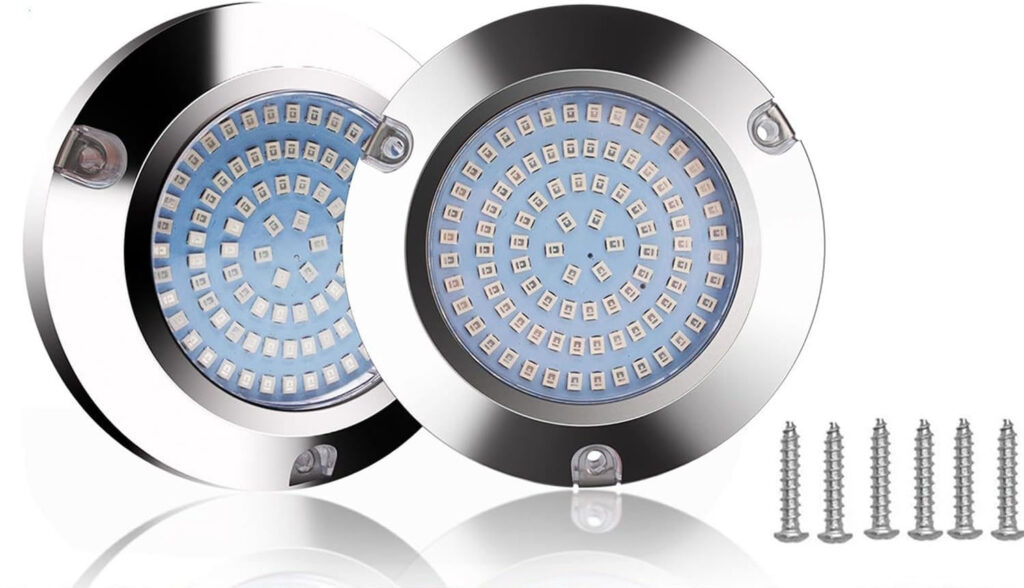
You also have many options when it comes to deck lighting. For instance, you can mount a series of recessed LED lights along the walls or beneath the covering boards. You can also mount an LED light strip to run the length of your pontoon boat.
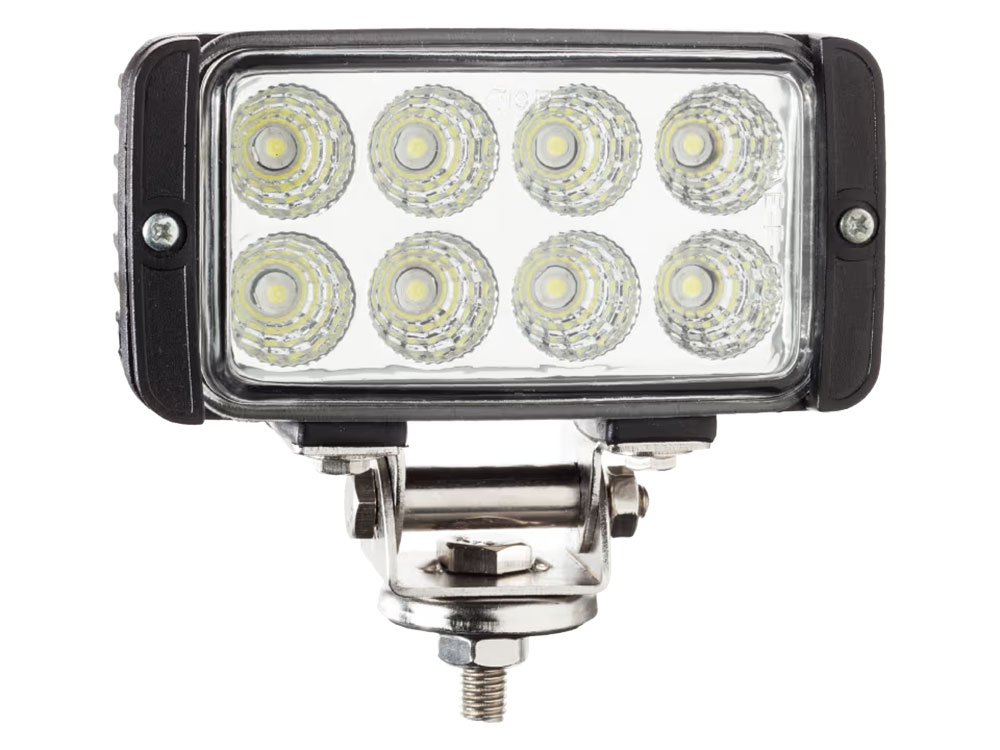
Other great varieties of pontoon boat LED lights include:
- Spreader lights to illuminate where you’re going
- Utility livewell lights
- Tube lights that light the console
Boating’s Top Spotlights for Boaters provides a breakdown of spotlight options for your pontoon boat.
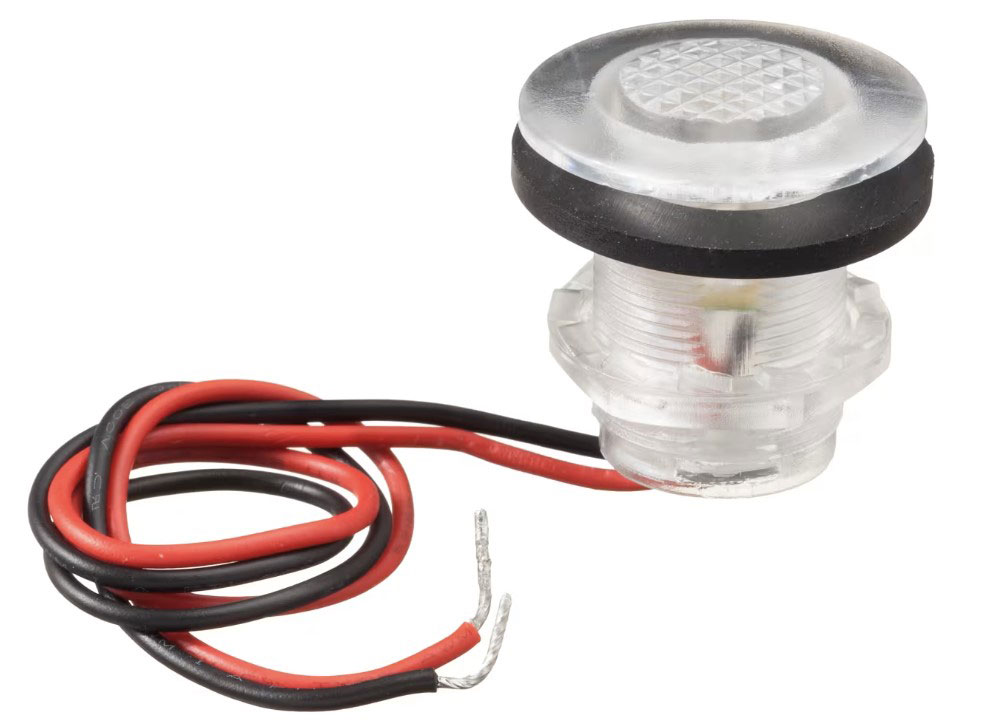
Benefits of LED Lights for Pontoon Boats
LED lights for pontoon boats provide a wide ranging number of benefits. They provide a significant energy savings and produce less heat than other forms of lighting.
The primary benefits include:
- Energy efficiency : LED lights draw less battery power to produce the same number of lumens than do halogen or incandescent lights.
- Longevity and durability : When properly maintained, LED lights last longer and stand up to the elements. If you do need to replace a bulb, they’re more consistent between lights than other types of lighting.
- Brightness and visibility : LED lights produce more light in smaller packages than other types of boat lighting.
- Versatility in color: LED lighting systems allow you to customize the color of your boat’s lighting. You can also control many LED light kits with apps.

Installing Pontoon Boat LED Lights
Just as there are many LED lighting products, you have a range of installation options. Hire a professional, or install them yourself. Integrate all your pontoon boat LED lights into a single circuit, or install and control them individually.
Check out the 2024 Pontoon Boat Buyer’s Guide for some design inspiration. This review of the SunCatcher Elite provides some additional perspective.
Marine Mounting Considerations
Where and how you mount your LED lighting systems depends on your boat’s setup and the look you’re after. You can install a series of individual recessed lights or mount an LED strip on a track .
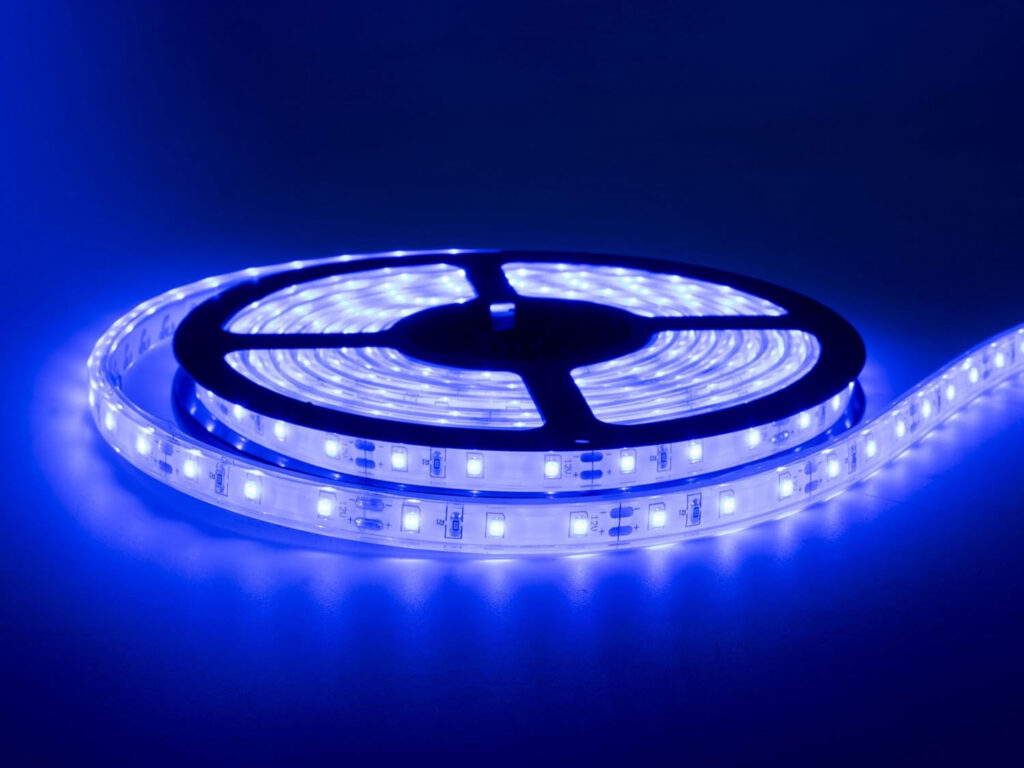
Professional vs. DIY Pontoon Light Installation
Most LED lighting systems are wired into your pontoon boat’s battery system. If you are technical, you may be able to install a new lighting system or modify the one you have.
Professional installation is a great option, too. Professionals understand your boat’s voltage (and can make sure to install the appropriate lights). Most LED manufacturers make them in 12V and 24V options.
How you install LED lights on your pontoon boat also depends on how complex and feature-rich you’d like your system to be. When you start including dimmability and app control, or integrating different LED lighting components, the installation gets more complex.
Maintaining LED Pontoon Lights
When properly maintained, your pontoon boat LED lighting system will last a long time. Clean and dry the lights after use to keep them in ship shape. Make sure that your connections are secure and that the wiring and batteries stay dry.
If you use your pontoon boat in saltwater, take extra care to avoid corrosion. Also, be sure to test your navigation lights before you leave the dock. Being in the middle of the lake at night is no time to find out that your lights are out.
Make a Safe Investment in LED Pontoon Boat Lights
So you’ve got your pontoon boat. You know the many benefits of LED lighting setups. Now it’s time to bring a fully customized, brighter LED setup to the biggest party on the water. Pontoon boats are great. They’re even better with LEDs.
What lights should be on when boating at night?
You’ll need navigation lights (a red and green light on the bow), stern lighting on the back of your boat, a masthead light, and an all-around light. These are the basics, and you can of course add to this.
Where do the lights go on a pontoon boat?
To satisfy the law, you’ll need lights on the bow, on the stern, and atop the console. From there, you could illuminate the deck, any steps, and maybe even beneath the water’s surface under your pontoon boat. Where you place them depends on the design you’re after.
Will lightning strike a pontoon boat?
Any time you are on the water, you should be aware of the weather. If there is lighting in the vicinity, you should consider heading to shore. Lighting can strike boats of all kinds, pontoon boats included.
- More: Affiliate , Gear , Lighting , Pontoon Boats
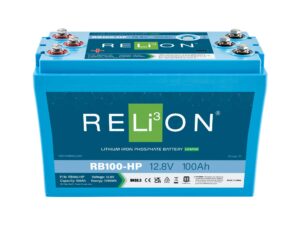
ReLiOn RB100-HP Starting Battery

Boating’s Deals of the Week

What Are the Best Boat Porta Potty Toilets?
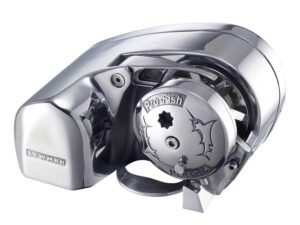
Ultimate Boat Anchor Winch Buyers’ Guide
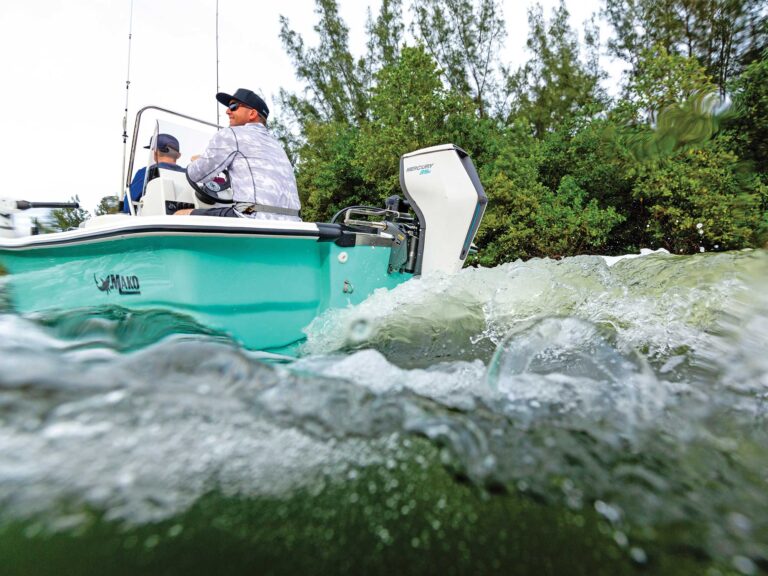
Decoding the Horsepower Ratings of Electric Motors
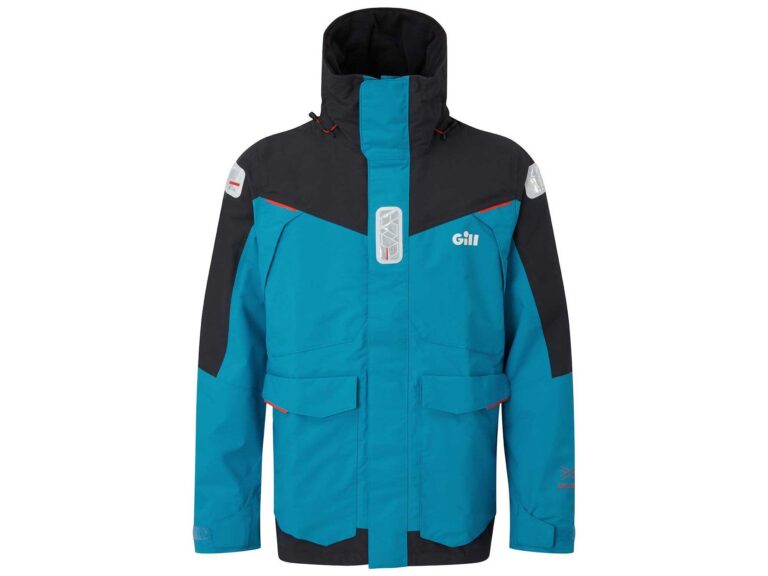
Volvo Penta D6 Diesel DPI

- Digital Edition
- Customer Service
- Privacy Policy
- Terms of Use
- Cruising World
- Sailing World
- Salt Water Sportsman
- Sport Fishing
- Wakeboarding
Many products featured on this site were editorially chosen. Boating may receive financial compensation for products purchased through this site.
Copyright © 2024 Boating Firecrown . All rights reserved. Reproduction in whole or in part without permission is prohibited.

Scott Peterson Goes On Camera to Share His Theory on Laci's Murder

Check Out Kate Hudson's Lit Las Vegas Vacay With The Fam!

Porn Star Sophia Leone's Cause of Death Revealed

Can You Guess the Water-Falling Stud In This Slippery Snap?

Sean Strickland Claims Megan Fox Sent Him 'F***ed Up' DM After Comment About Her Kids
Man brandishing gun gets shot in road rage incident, indianapolis road rage man brandishes gun, gets shot & killed ... shooter free, self-defense.

An Indianapolis man is dead after another driver shot him at point-blank range during a road rage incident caught on video -- and cops have released the man who fired the fatal shots.
In the video, a man rushes to the driver's side of a large white truck ... with what appears to be a gun in his hand, and he's screaming at the other motorist while punching his door during the Tuesday incident.

Watch closely ... because when he's rushing up to the car, the gun's in his right hand -- but, when he reaches the door he switches it to his left before raising his arm and pointing.
That's when the other driver points his own gun and fires 3 fatal shots.
The victim -- later identified by Indianapolis Police as Gavin Dasaur -- drops to the ground, clearly injured.

The Indianapolis Metropolitan Police Department tells TMZ ... officers responded to a call that a person had been shot after 8 PM Tuesday. When they arrived at the scene, they found Dasaur injured and transported him to a local hospital where he was pronounced dead.
Cops say they detained the shooter at the scene, but let him go after consulting with the Marion County Prosecutor’s Office. Local reports say they determined this might have been a case of self-defense, and released the alleged shooter.

Watch the video again, it seems to support the self-defense theory -- the guy inside the truck never sees Dasaur switch his weapon to his left hand, so he likely thought Dasaur was about to fire when he pointed his hand inside the truck.
Dasaur got married just a few weeks ago to Cinthya ZaMora ... who said her husband didn't deserve to die and "was murdered in cold blood."
- Share on Facebook
related articles

Woman Gets Instant Karma in Road Rage Incident, Car Crashes into SUV

Driver Stabs Another Motorist As Road Rage Incident Escalates, Wild Video
Old news is old news be first.
- Jefferson City
- Download Our Apps
- Question of the Day
- ABC 17 Investigates
- ABC 17 Stormtrack Doppler Radar
- ABC 17 Stormtrack Insider Blog
- ABC 17 Stormtrack Weather Alert Days
- Closings and Delays
- Super Bowl 2024
- High School Sports
- Mizzou Tigers
- SportsZone Football Friday
- SportsZone Basketball
- Election results
- 2024 Voter Guide
- Columbia City Government
- Jefferson City Government
- Livestream Special Coverage
- Livestream Newscasts
- A Family For Me
- Healthy Living
- Health & Wellness
- House & Home
- Healthy Pets
- Community Calendar
- Entertainment
- Submit Tips, Pics and Video
- Work for KMIZ
- Explore Local Jobs
- Intern with KMIZ
- Advertise With Us
- Meet the Team
- Jobs/Internships
- Closed Captioning
- EEO Public Filing
- FCC Public File
- TV Listings
20 passengers killed and hundreds missing in Congo boat accident
Associated Press
KINSHASA, Congo (AP) — Local officials in western Congo say that a weekend boat accident on the Lukeni river has left at least 20 people dead and hundreds missing. Jacques Nzenza Mongie, the administrator of Kutu territory, says that the motorized wooden boat was carrying around 300 passengers and navigating by night when it crashed into a sunken barge. It was the latest deadly boat accident in the central African country, where overloading is often to blame. In June, 80 passengers lost their lives when an overloaded boat sank near the capital.
Jump to comments ↓
ABC 17 News is committed to providing a forum for civil and constructive conversation.
Please keep your comments respectful and relevant. You can review our Community Guidelines by clicking here
If you would like to share a story idea, please submit it here .
- Central Oregon
- Decision 2024
- Oregon-Northwest
- Crime Stoppers
- KTVZ.COM Polls
- Special Reports
- Ask the Mayor
- Interactive Radar
- Local Forecast
- Road Conditions – Weather Webcams
- Livestream Newscasts
- Livestream Special Coverage
- Local Videos
- Photo Galleries
- 21 Cares For Kids
- Clear The Shelters
- Community Billboard
- Community Conversations
- Community Links
- One Class At a Time
- Pay it Forward
- House & Home
- Entertainment
- Events Calendar
- Pump Patrol
- 2024 Back 2 School Photos
- Show Us Your Garden 2024
- Central Oregon Backyard Living Photo Contest 2024
- Junior Forecaster
- Pet Pics Sweepstakes
- Sunrise Birthdays
- Submit Tips, Pics and Video
- KTVZ Careers
- Central Oregon Careers
- Email Newsletters
- Advertise with NPG of Oregon
- Careers and Internships
- Closed Captioning
- Download Our Apps
- EEO Public Filing
- FCC Public File
- NewsChannel 21 Team
- On-Air Status
- Receiving KTVZ
- TV Listings
A tornado sank a luxury sailing boat off the coast of Sicily. Here’s what we know
By Barbie Latza Nadeau and Sana Noor Haq, CNN
(CNN) — Emergency workers in southern Italy are still hunting for six people missing after a tornado sank a luxury yacht early Monday – prompting an air and naval operation off the coast of Sicily .
Fifteen people were rescued from the wreckage on Monday, according to Italy’s Coast Guard. One body was later recovered from the hull of the stricken vessel.
Two Americans and four Britons are among those missing – including British tech tycoon Mike Lynch, Jonathan Bloomer, chairman of Morgan Stanley International, and Chris Morvillo, a prominent lawyer.
Here’s what we know.
What happened?
A small waterspout – a type of tornado – spun over the Mediterranean island early Monday, likely capsizing the sailing boat amid lashings of rain and strong thunderstorms.
The British-flagged yacht, called the “Bayesian,” was anchored about a half a mile from the port of Porticello, on Sicily’s northern coast. The vessel sank after its mast broke in half in the storm, Salvatore Cocina, head of Sicily’s Civil Protection, told CNN on Tuesday.
Eyewitnesses described furious gales and hurricane-like winds that left an avalanche of debris near the pier.
More than a dozen survivors were spotted in the area hanging onto life rafts, according to the captain of a nearby boat, who steadied his ship to avoid colliding with the Bayesian.
“We got this strong hurricane gust and we had to start the engine to keep the ship in an angled position,” Karsten Bower told reporters in Palermo on Monday. “After the storm was over, we noticed that the ship behind us was gone.”
Bower and his crew rescued four injured people, he said, before calling Italy’s Coast Guard – who later rescued the remaining survivors.
One of those rescued – a child – was airlifted to the children’s hospital in Palermo. Eight people were hospitalized in total, according to the mayor’s office.
The girl’s mother, Charlotte, described how she battled to hold onto Sofia, her 1-year-old daughter, as reported by Italian news agency ANSA.
“In two seconds I lost the baby in the sea, then I immediately hugged her again amidst the fury of the waves. I held her tightly, close to me, while the sea was stormy,” she told journalists. “Many were screaming.”
The mother and daughter were later reunited with the father, James, according to a doctor at the local children’s hospital in Palermo.
“The survivors are very tired and are constantly asking about the missing people,” the doctor, Domenico Cipolla, said Monday. “They are talking and crying all the time because they have realized that there is little hope of finding their friends alive.”
Italy’s fire brigade dispatched helicopters to aid in the search, officials said Monday. The brigade also said they would send divers to try and enter the sunken ship Tuesday, after an unsuccessful attempt on Monday.
The depth of the wreck means divers can only work there for limited periods of time, according to Marco Tilotta, an inspector for the diving unit of Palermo’s local fire brigade. The Italian fire brigade said Monday its divers had reached the yacht’s hull 49 meters (160 feet) below sea level.
The United Kingdom’s Marine Accident Investigation Branch (MAIB) will also deploy a team of four inspectors to Palermo to conduct a preliminary assessment of the scene, a source familiar with the operations told CNN, on the condition of anonymity.
Who was on board?
Twenty-two people were on board the Bayesian, which was flying under a British flag and had mostly British passengers and crew, in addition to two Anglo-French, one Irish and one Sri Lankan person, a spokesperson for Italy’s Coast Guard told CNN.
A troupe of high-profile guests are among those missing, including Lynch, the 59-year-old British tech investor who fought a fraud case earlier this year in the United States – which spiraled from the disastrous $11 billion sale of his company to tech firm Hewlett-Packard (HP) in 2011.
His 18-year-old daughter was also named missing. Lynch’s wife, Angela Bacares, survived the accident. Bacares told Italian daily newspaper La Repubblica that she woke up at 4 a.m. local time, as the boat tilted. She and her husband were not initially concerned, she said, but became worried when the windows of the yacht shattered and chaos erupted.
Bacares spoke to the newspaper while sitting in a wheelchair, at a hospital in the Sicilian town of Termini Imerese. She had abrasions on her feet and bandages on other parts of her body, it reported.
Bloomer, the finance tycoon, and Morvillo, a prominent lawyer – and both their wives – are also among the missing, according to Salvatore Cocina, head of Sicily’s Civil Protection.
Morvillo, an American partner at Clifford Chance, was involved in successfully defeating the US fraud case against Lynch in June. Another employee of the firm, Ayla Ronald, and her partner, survived the incident, according to a spokesperson for Clifford Chance.
The body that was recovered from the vessel was identified as the onboard chef Ricardo Thomas, an Antiguan citizen, Reuters reported.
What do we know about the boat?
Built in 2008, the 56-meter (184-foot) yacht was manufactured by Italian company Perini Navi, Reuters reported. According to the Associated Press, the boat has been available for charter for $215,000 (€195,000) per week.
Lynch’s wife is linked to the yacht. The Bayesian is held by the company Revtom Limited, according to records from the maritime information service Equasis. The company’s latest annual return from April lists Bacares as the proprietor.
“Bayesian,” the name given to the vessel, is linked to the statistical theory on which Lynch built his fortune, according to Reuters.
The yacht’s mast stood 72.27 meters (237 feet) high above the designated water line, just short of the world’s tallest mast which is 75.2 meters, according to Guinness World Records. It was the tallest aluminium mast in the world, the Perini Navi website said.
Perini Navi is known for making “good quality boats,” according to Caroline White, deputy editor of BOAT International, a media group serving the superyacht industry.
White told CNN that if the Bayesian dismasted, “it should theoretically become more stable.” “But it might be a different story if you are in the middle of a violent storm with incredibly strong winds pinning you to the water,” she added.
Dangerous weather conditions
Strong storms across Sicily brought torrential rainfall late Sunday. Initial reports suggest a small waterspout , which developed over the area Monday morning, could have been behind the yacht’s sinking.
Waterspouts – one of several types of tornadoes – are spinning columns of air that form over water, or move from land out to water. They are often accompanied by high winds, high seas, hail and dangerous lightning . While they are most common over tropical oceans, they can form almost anywhere.
Waterspouts rely on warm waters to gain energy and the Mediterranean Sea has been very hot, reaching a record daily median of 28.9 degrees Celsius (84 Fahrenheit) last week, according to preliminary data from researchers at the Institute of Marine Sciences in Spain.
Local temperatures have been even higher, with waters around Sicily reaching almost 30 degrees Celsius (86 Fahrenheit), almost 3 degrees more than normal, Italian climatologist Luca Mercalli told CNN.
“Warmer oceans have more energy and more humidity to transfer to the atmosphere, the most important fuels for storms,” he said.
The-CNN-Wire ™ & © 2024 Cable News Network, Inc., a Warner Bros. Discovery Company. All rights reserved.
CNN’s Laura Paddison, Louis Mian, Benjamin Brown, Catherine Nicholls, Sabrina Souza and Eve Brennan contributed reporting.
Jump to comments ↓
CNN Newsource
Related articles.

Panama deports 29 Colombian migrants on first US-funded repatriation flight

US sanctions former Haitian President Martelly over drug trafficking allegations
Russian soldier defects to ukraine after spying for resistance group for months.

Iran says it will not take ‘hasty action’ against Israel for killing of Hamas political leader
KTVZ NewsChannel 21 is committed to providing a forum for civil and constructive conversation.
Please keep your comments respectful and relevant. You can review our Community Guidelines by clicking here
If you would like to share a story idea, please submit it here .

YANMAR TO LAUNCH FIRST ELECTRIC PROPULSION PRODUCT TO U.S. MARKET AT NEWPORT INTERNATIONAL BOAT SHOW 2024
August 15, 2024
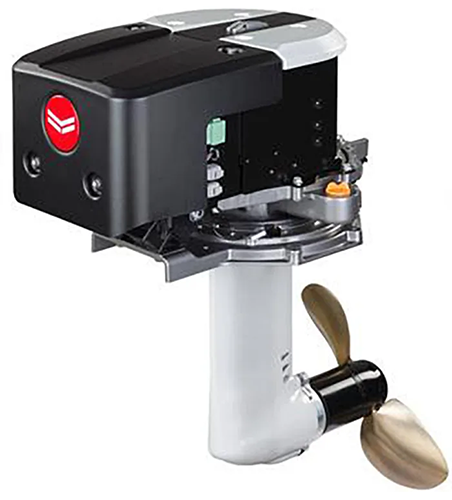
YANMAR Marine International (YMI) is set to launch its ‘plug and play’ E-Saildrive range to the global market at this year’s Newport International Boat Show (September 12-15), which is the marine engine innovators eagerly anticipated first step into electric propulsion. It is designed to give boaters a seamless transition to electric power by utilizing a straightforward installation platform.
The emissions-free saildrive is built on an integrated system with all the components on one ‘plug and play’ platform. It is fitted on existing footprints or as a drop-in replacement for combustion engines, making the switch to 100% electric boating easier and quicker. The E-Saildrive is offered in three models – the SDe7 kW, the SDe10 kW and the SDe15 kW.
The Electric Saildrive range is designed to the same high engineering standards as YANMAR’s combustion engines with full access to the same global support network.
The SDe15 kW saildrive will be shown at the YANMAR stand, Tent B, space B47. The YANMAR team will be available to provide information and answer questions on the E-Saildrive range.
Kevin Carlan, President of YANMAR Marine International Americas, said: “Our developers have developed an innovative, integrated system on a plug-and-play platform that simplifies the transition to electric propulsion for boaters. We are committed to a sustainability journey, and with the E-Saildrive solution, we aim to inspire boaters to join us in reducing our environmental impact, one step at a time.”
For further information or images, please contact the YANMAR team at McKenna Townsend by calling +44(0)1425 472330 or emailing [email protected]
About YANMAR Marine International
YANMAR Marine International (YMI) is driven to create innovative, environmentally responsible marine propulsion solutions through the exploration and progression of advanced technologies. With sustainability at its heart, the YMI mission is to meet the evolving needs of its customers as a trusted partner, supplying cutting-edge products and systems which enhance our customers’ experiences.
The sustainable solutions from YMI are built to help customers take the next step on their journey to minimize their CO2 footprint, while fulfilling their appetite for life-affirming adventure on the water and requirements for onboard comfort. YMI continues to grow its network of service centers worldwide, providing quick and reliable support in over 130 countries.
Based in the Netherlands, YMI is incorporated within YANMAR’s global operations. With its beginnings in Osaka, Japan in 1912, YANMAR is driven by its founding mission to benefit mankind and by a pioneering spirit for world-leading technology across seven business domains on land and at sea.
YANMAR has continued to expand its range of products, services, and expertise to deliver total solutions as an engine and equipment manufacturer, providing small and large engines, agricultural machinery and facilities, construction equipment, energy systems, marine engines, machine tools, and components.
Sign-up to receive the latest information about new products, services, and general updates.
YANMAR’S extensive global service and parts network spans 130 countries and over 2100 locations.
We’re here to help and would love to hear from you. Contact us with inquiries, comments, and feedback.
Elige tu idioma
Choisissez votre langue, velg ditt språk.
Nederlandsk
Portugisisk
Välj ditt språk
Portugisiska

IMAGES
COMMENTS
Lights When Sailing. The specific rules for a sailboat under sail are in COLREGS Rule 25 and vary slightly with the size of the boat. A sailboat powering is considered a power boat and falls under in Rule 23. Under 23 feet (7 meters) - side lights and a stern light, possible. If these lights can not be displayed a light must be kept at hand to ...
As such a power boat, and by extension all sailboats, MUST, without question show one green light on the starboard bow and one red light on the port bow and one all around white light or lights while operating in reduced visibility. These lights should shine at all 360 degrees of visibility with the bow lights shining at an angle of dead ahead ...
On any vessel, navigation lights have a specific color, (white, red, green, yellow, blue), arc of illumination, range of visibility, and location, as required by law and regulations. For the purposes of this course, we will concentrate on pleasure boats under 65 feet in length. Knowledge of navigation lights is important to a small-boat skipper ...
Powerboat under 23 feet (7m) Powerboats under 23 feet are required to have the following navigation lights displayed: One white masthead light visible for 2 miles. One red & green sidelight visible for 1 mile. One stern light visible for 2 miles. One white, red, green, or yellow all-round light visible for 2 miles.
The basic rule is that sidelights and a stern light are required. Permissible variations to this rule appear below. Sailboats less than 20m (65.7') can substitute a tricolor light for separate sidelights and stern light—or a bi-color light and a stern light may be substituted. Sailboats less than 7m (23') shall, if practicable, exhibit lights ...
Vessel length: 12 meters to 20 meters (39.4 FT. to 65.6 FT.) Lighting requirement: A white masthead light located at the front of the boat, pointing in the direction you are traveling. This must be visible at 225 degrees and from two miles away. The masthead light must be positioned at least 8 feet above the gunnel.
Red and green sidelights, one sternlight, and two all-round lights in a vertical line (upper red, lower green) also meet the navigation lights requirement for sailboats that are not operating under engine power (Rule 25). One combination red, green, and white light exhibited near the top of the mast meets the navigation lights requirement for ...
These lights play essential roles in identifying the ship's length, direction, and purpose! The colored marker lights and where to find them go as follows: The boat's port side is marked with a red light. The starboard side light is green. When looking at the boat's transom or stern, a white light may be visible.
A vessel that is over 7 m or 23 ft in length is expected to show red and green sidelights when sailing. Each of these lights needs to cover an arc of 112.5°. The sidelights may be combined in one lantern at the bow when below 25 m or 65 ft. The white stern light can be seen over an arc of 135°.
Stern light. A white light mounted as close to the stern as possible and shines dead ahead in an arc of 135° (67.5° to each side). The mounting height should be aligned to the height of the side lights and should never be higher. 3. Three-colour light for sailing vessels (sailing lights) On sail boats up to a length of 20 m, the side light ...
These lights are highly versatile and can be used on pontoons, fishing boats, skeeters, and speed boats. They come at a competitive price but work just as well as some of the pricier models. The lights consist of eight LEDs in a bulb to offer exceptional brightness that covers at least a mile of distance. Attwood 14190 Boat Navigation Lights
Updated: November 2, 2017. USCG Required Navigation Lighting West Marine. Powerboats under 12 meters (39.4 feet) in length must have separate or combined red and green sidelights covering 112.5 degrees and visible for 1 nautical mile. The white masthead light must cover 225 degrees, be 1 meter above the sidelights and be visible for 2 nautical ...
Lighting requirements are specific for the size of the boat and if she is underway. In the U.S., on powerboats shorter than 39'3" (12 meters) long must have separate or combined red and green side lights covering 112.5 degrees and visible for one nautical mile. The white stern light must cover 135 degrees and be visible for 2 nautical miles or you can substitute one 360-degree all-around ...
Recreational powered boats between 40 feet and 164 feet: This size of boat requires two white lights which, combined, make up 360 degrees of visibility: A white masthead light at the bow, visible across 225 degrees, from 2 nautical miles away. This light must be attached at least 8 feet above the gunnel.
Rule 29, duty shall exhibit: at or near the masthead, two all-round lights in a vertical line, the upper being white and the lower red; when underway, in addition, sidelights and a sternlight; as shown in the example below. Pilot boat, shorter than 50 m. Abeam, starboard side.
The absence of this light indicates a sailing vessel because sailboats under sail display only sidelights and a sternlight. All-Round White Light: On power-driven vessels less than 39.4 feet in length, this light may be used to combine a masthead light and sternlight into a single white light that can be seen by other vessels from any direction ...
Navigation lights must be displayed on a boat if you are operating your boat at night or in poor visibility. The term "night" here refers to the period between sunset and daybreak. During the daytime, poor visibility can refer to heavy fog or even inclement weather, such as rain or snowfall. In this article, Drive a Boat Canada explains all ...
The Inland Rules have specific requirements as to anchor lights. That rule is quoted below, as is the USCG site reference. A 360-degree white all-around masthead light with two-mile visibility normally fulfills this requirement for most pleasure boats, but familiarize yourself with and follow the rule. Wire gauge, length of wiring, connections ...
Required Lights: Sailboats When Underway. If less than 65.6 feet long, these vessels must exhibit the lights as shown in Figure 2. The required lights are: Red and green sidelights visible from a distance of at least two miles away—or if less than 39.4 feet long, at least one mile away—on a dark, clear night. A sternlight visible from at ...
Sailboats are required to have three lights at a minimum: a masthead light, a red port light, and a green starboard light. The masthead light is white and is located at the top of the mast. This light should shine forward and aft and be visible from 2 nautical miles away. It is important to ensure that the masthead light is not obstructed by ...
4 Types of Boat Lights. The red and green lights that go on the sides of a boat are known as sidelights. White lights that only face backward are known as stern lights, and white lights that face forward are known as masthead lights. An all-round white light is a white light that faces 360 degrees.
Sailboat-Specific Navigation Light Rules. Sailboats must have the same red and green lights as powerboats. The difference is that you'll need other ones on the stern and mast. If your boat is less than 65 feet, you can use either a combination of a bicolor light with red and green along with another at the stern or a tricolor one on top of ...
The most common of our navigation lights are our "running lights". This is a red light on the port side of the boat and a green light on the starboard side that shine from the bow to 22.5 degrees abaft the beam of the boat. This creates a 112.5-degree arc on either side of the vessel. To complete a 360-degree circle, our white stern light ...
Navigation lights: These are the classic red and green lights mounted on the bow of your boat. In addition to being required by law, they let other vessels know which direction you are traveling at night. Stern lights: You also need stern lights mounted on the back of your boat and an all-around light.
An Indianapolis man is dead after another driver shot him at point-blank range during a road rage incident caught on video -- and cops have released the man who fired the fatal shots.
Explore and buy the Air Jordan 1 Low x Chris Paul 'Light Cream and Sail'. Stay a step ahead of the latest sneaker launches and drops. ... The intricate embossed floral upper blooms against Light Cream suede accents. A translucent outsole reveals a hidden bouquet underfoot, while a vibrant floral print pops on the insoles. Sophistication, simply ...
Associated Press. KINSHASA, Congo (AP) — Local officials in western Congo say that a weekend boat accident on the Lukeni river has left at least 20 people dead and hundreds missing.
A small waterspout - a type of tornado - spun over the Mediterranean island early Monday, likely capsizing the sailing boat amid lashings of rain and strong thunderstorms.
yanmar to launch first electric propulsion product to u.s. market at newport international boat show 2024 August 15, 2024 YANMAR Marine International (YMI) is set to launch its 'plug and play' E-Saildrive range to the global market at this year's Newport International Boat Show (September 12-15), which is the marine engine innovators ...